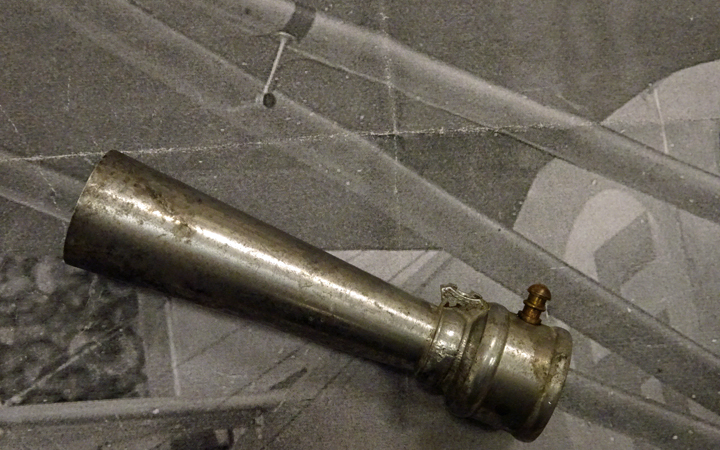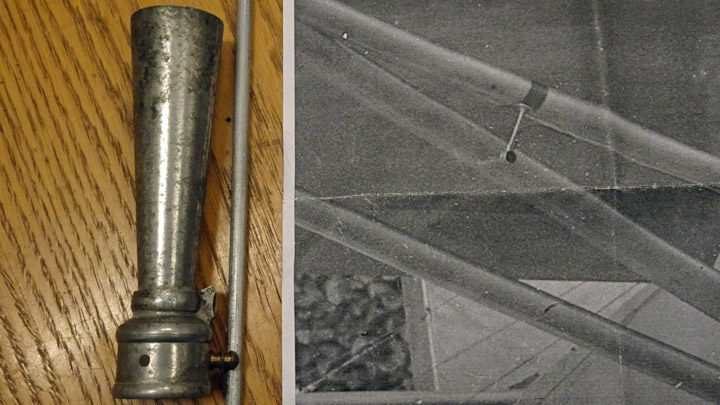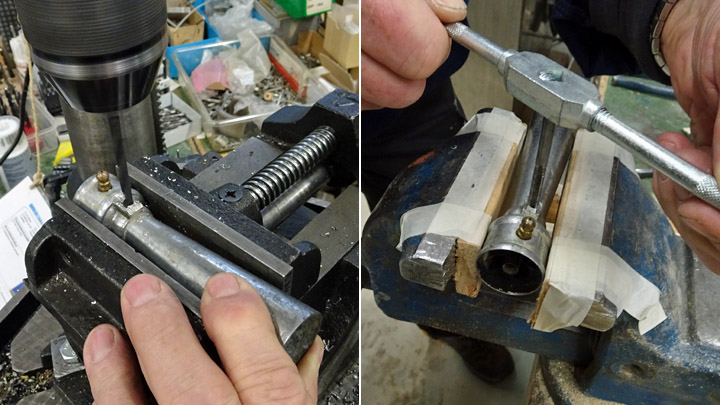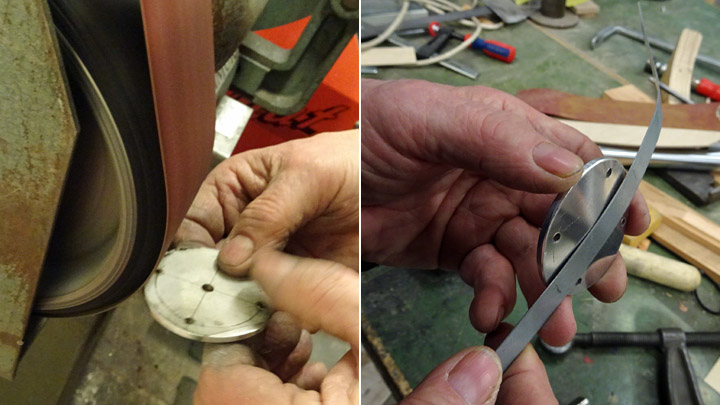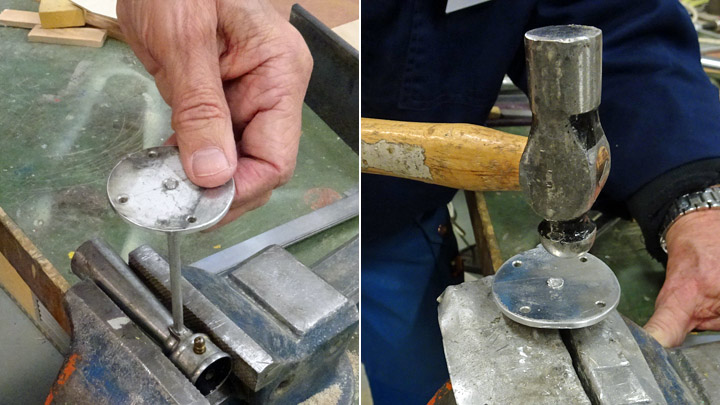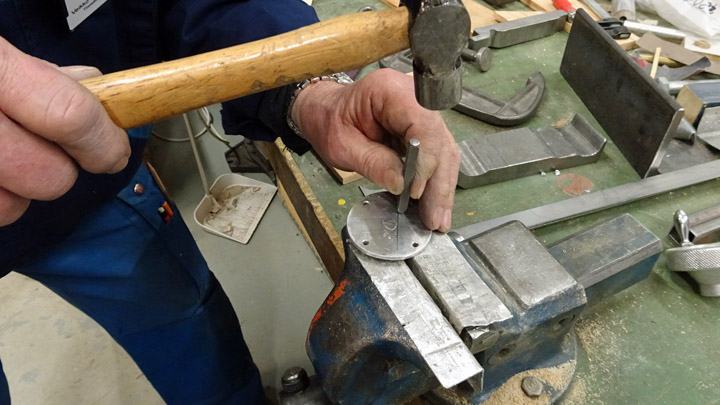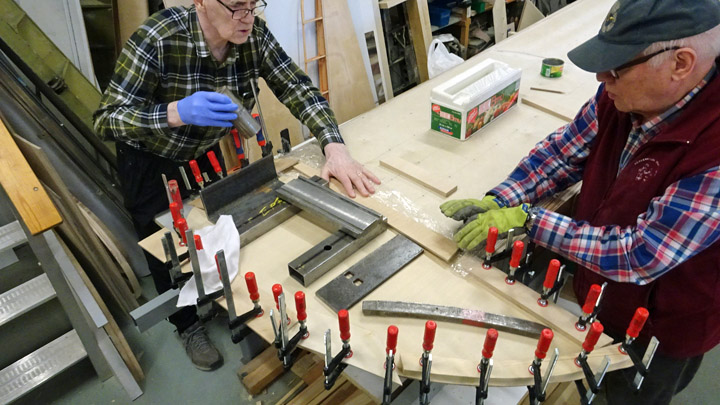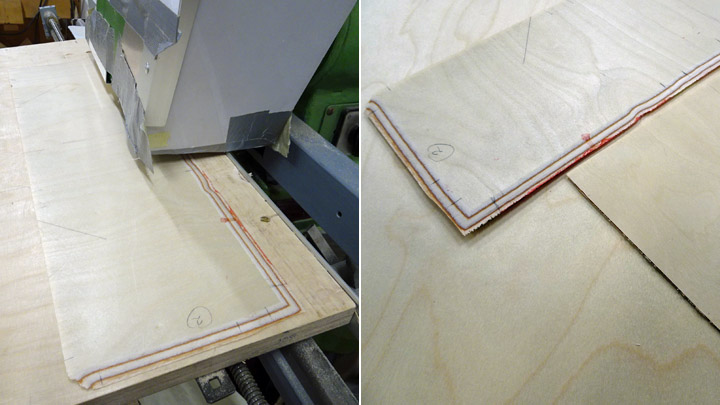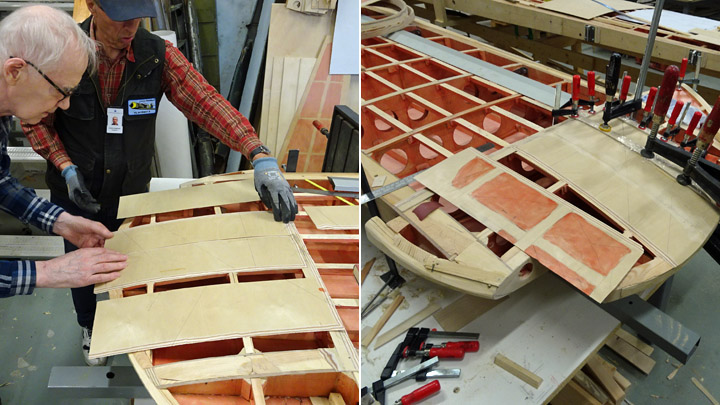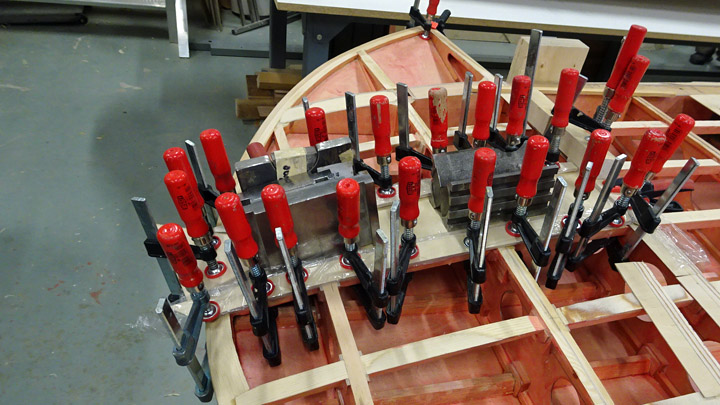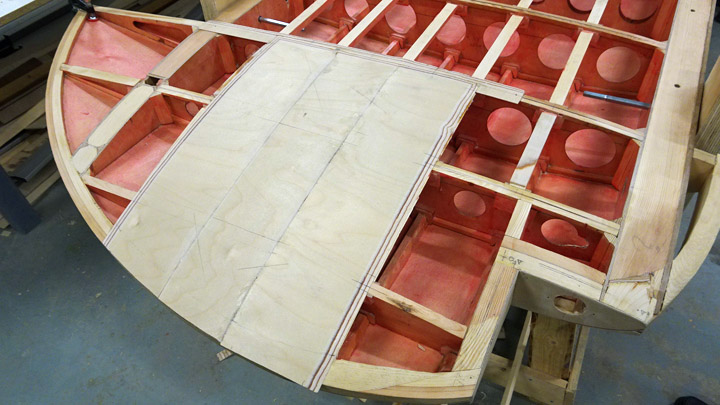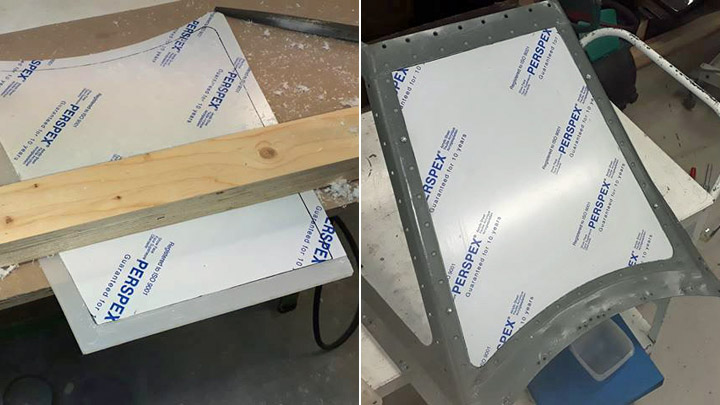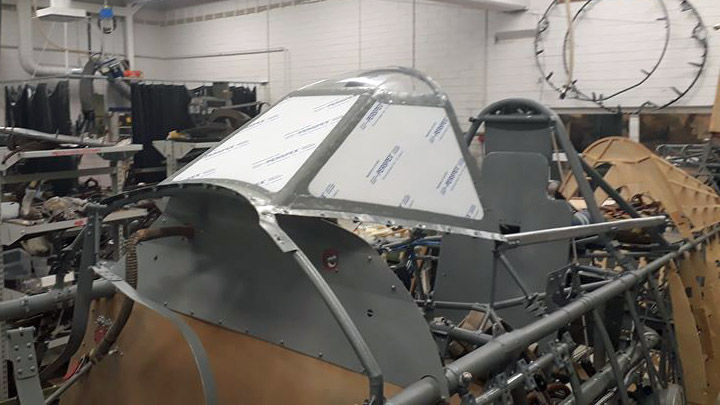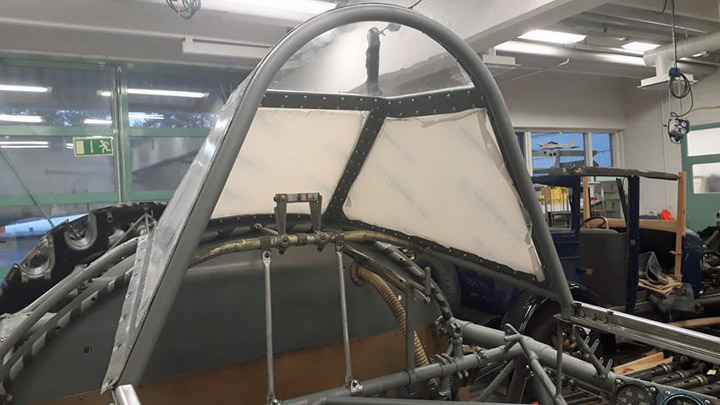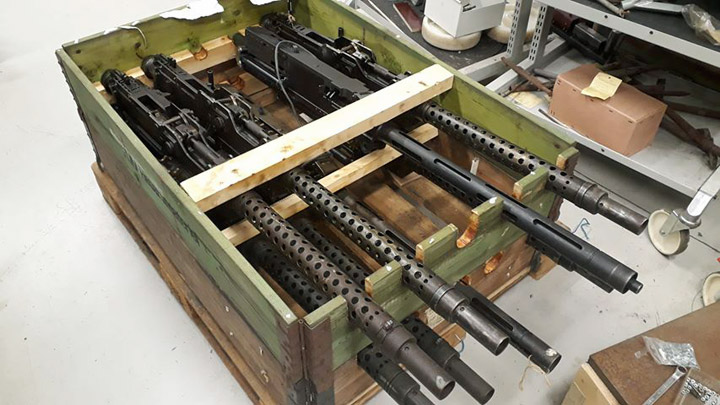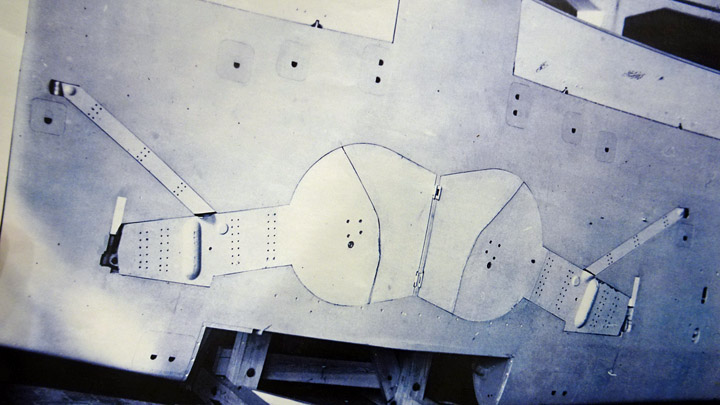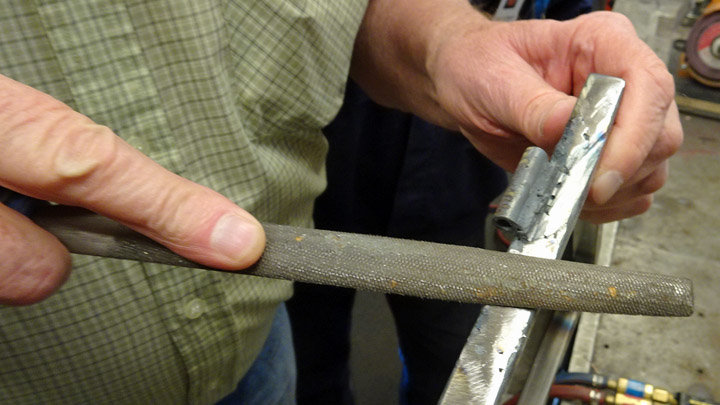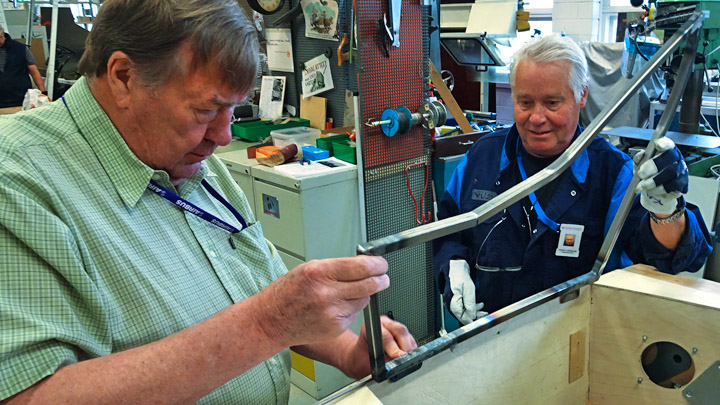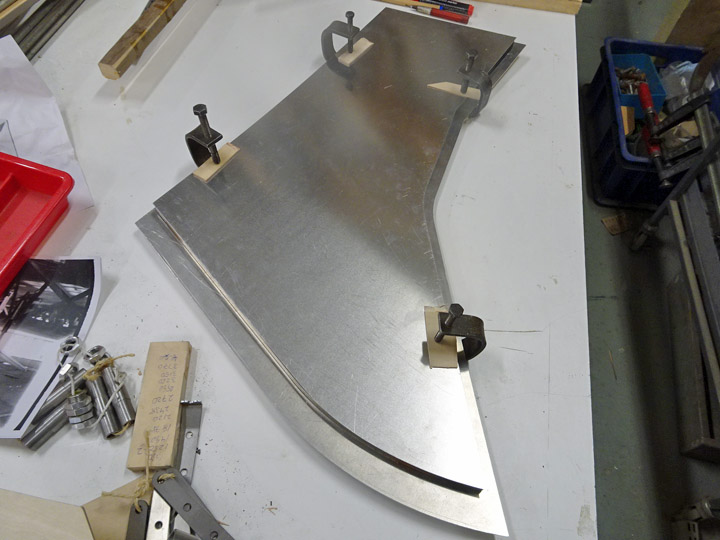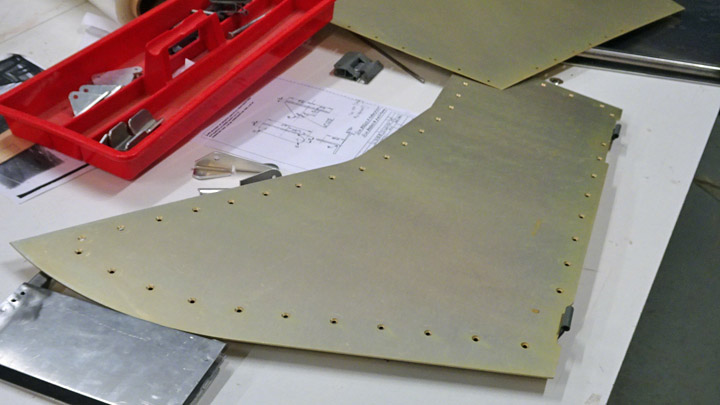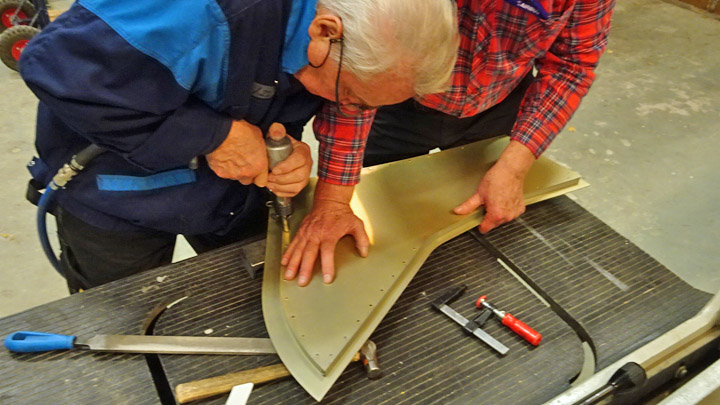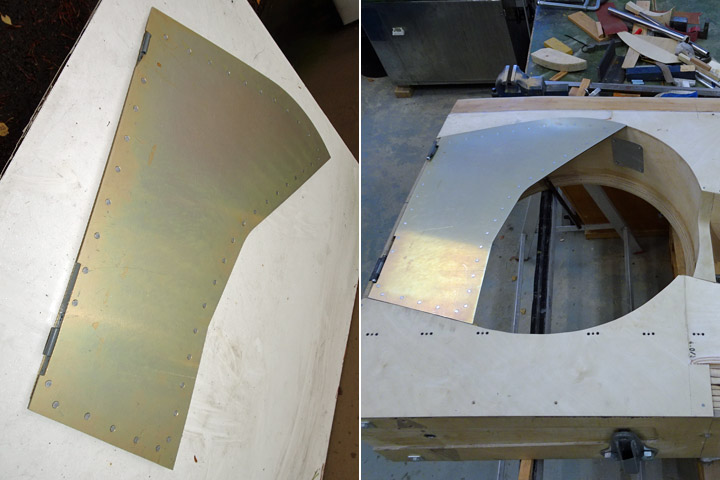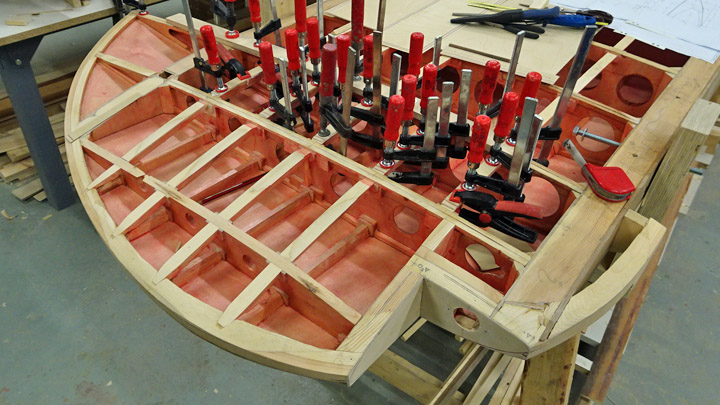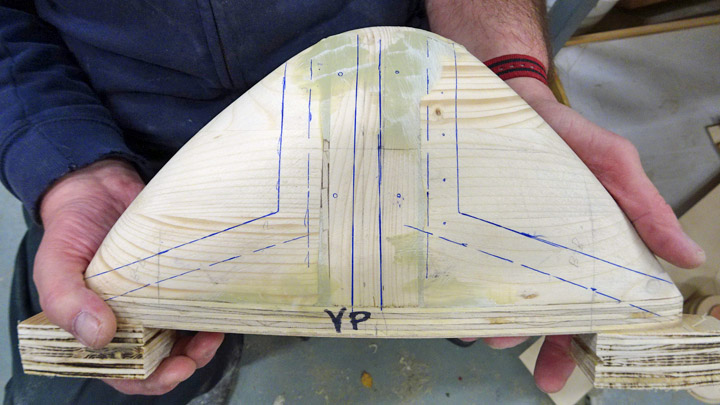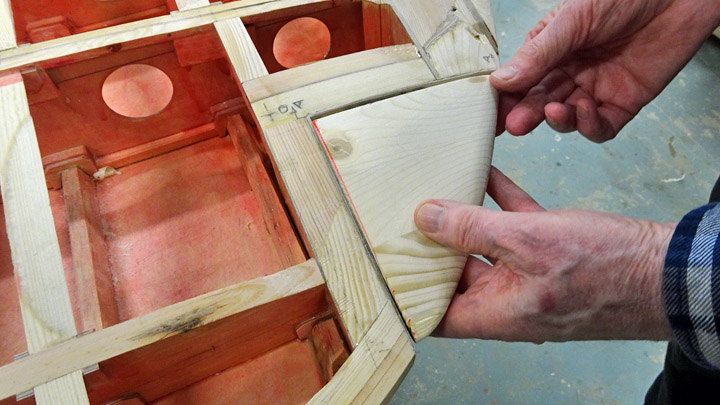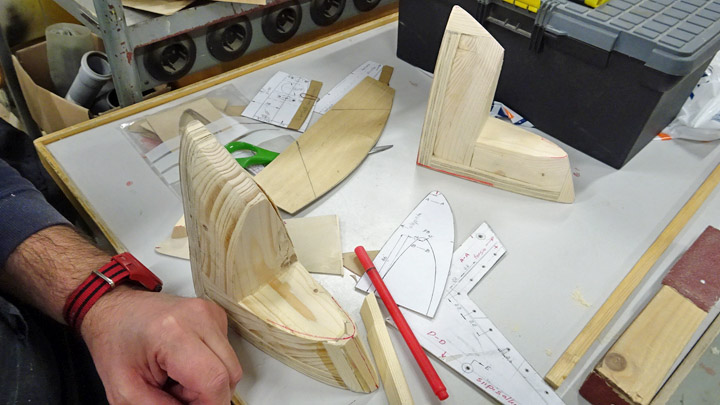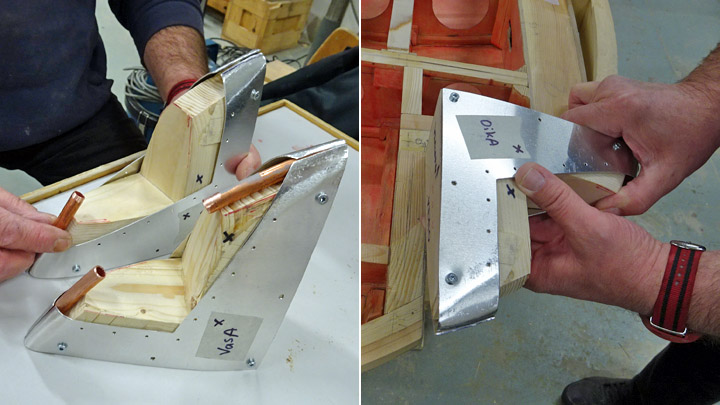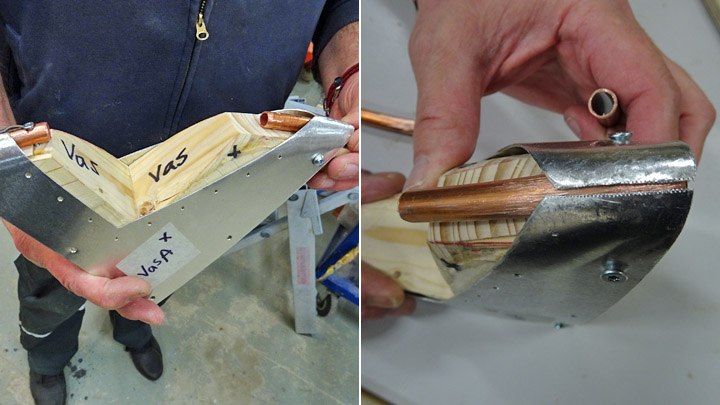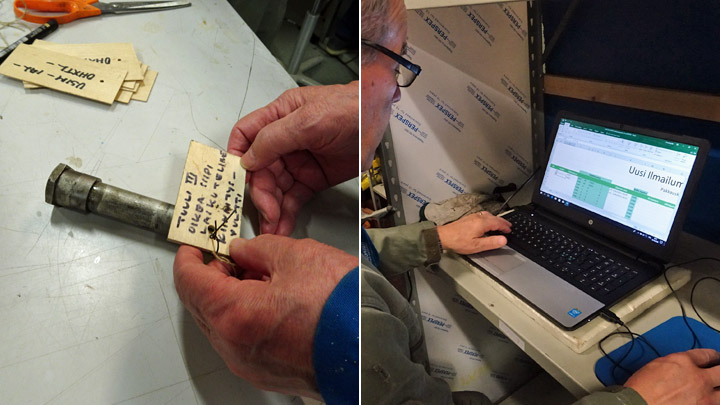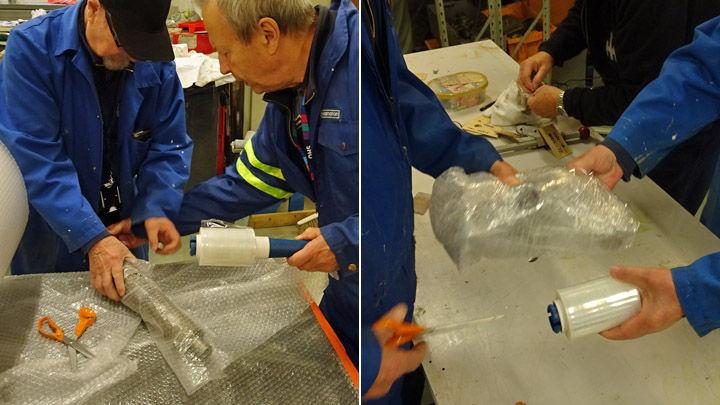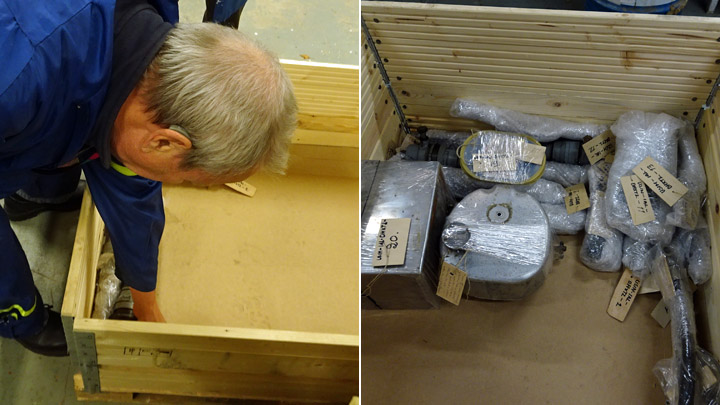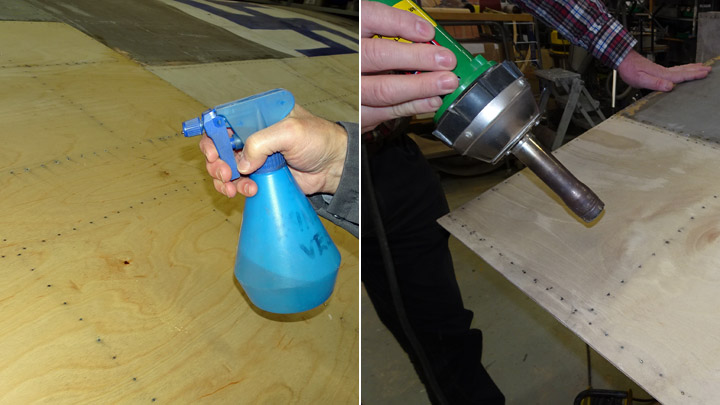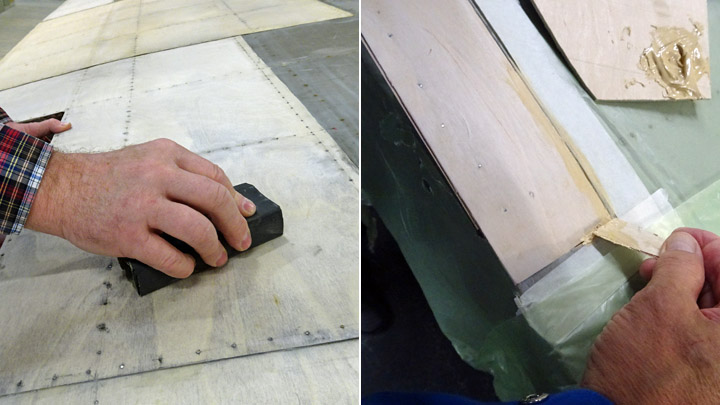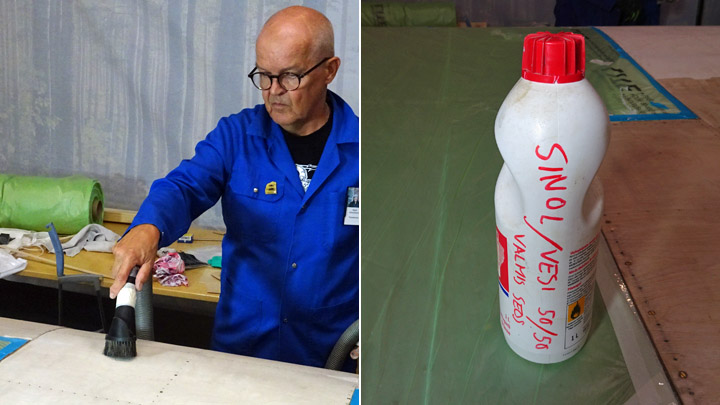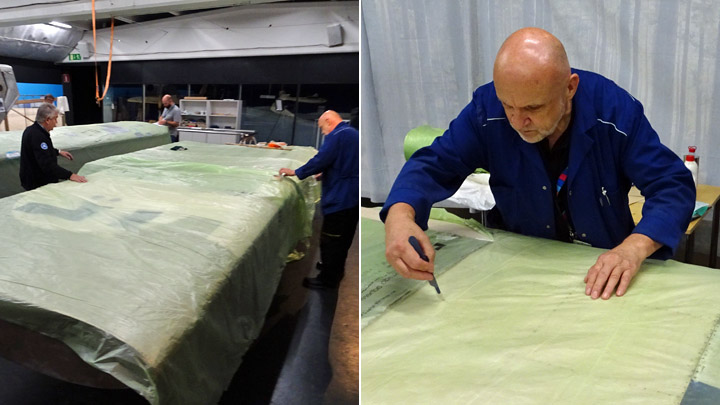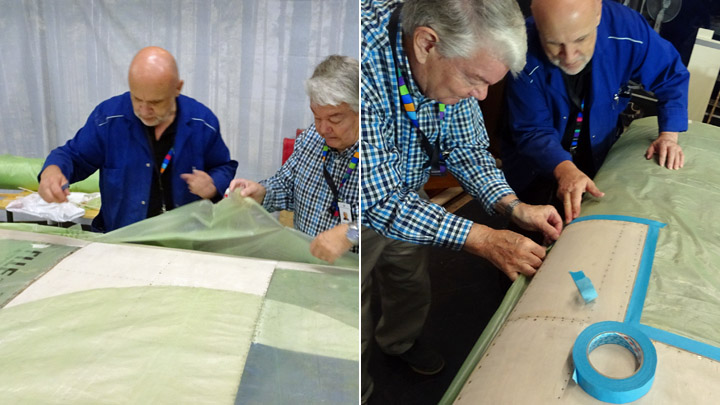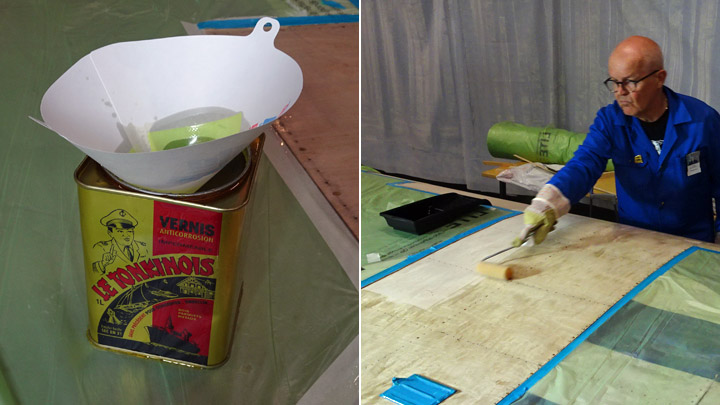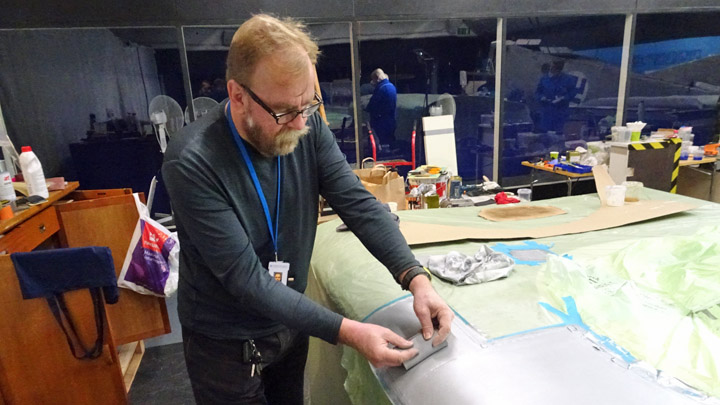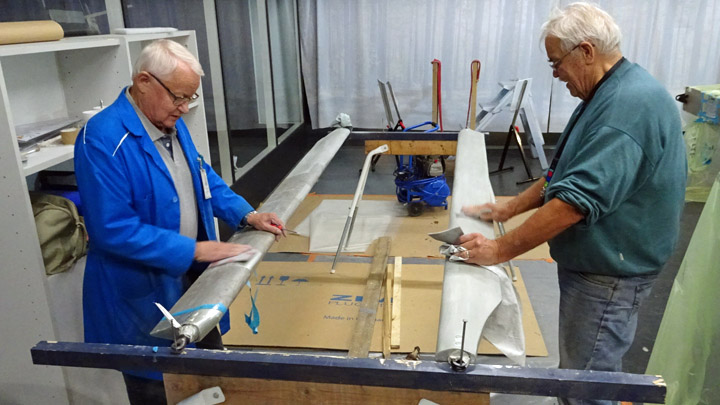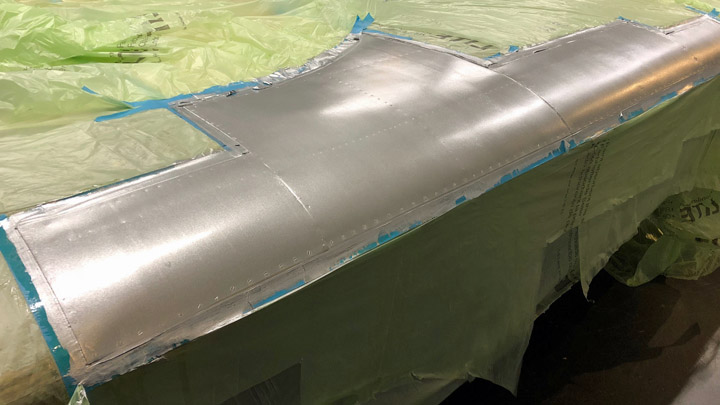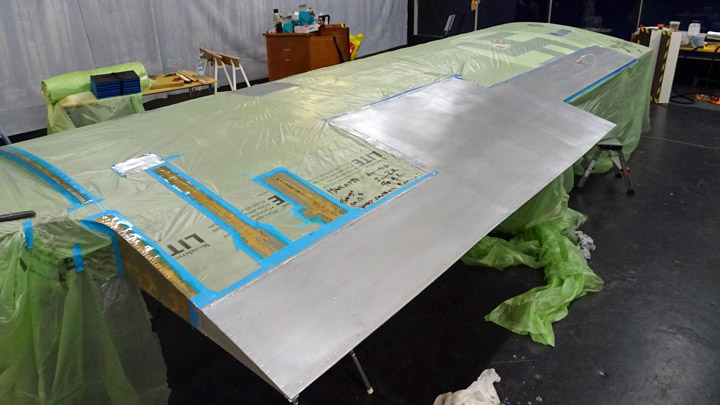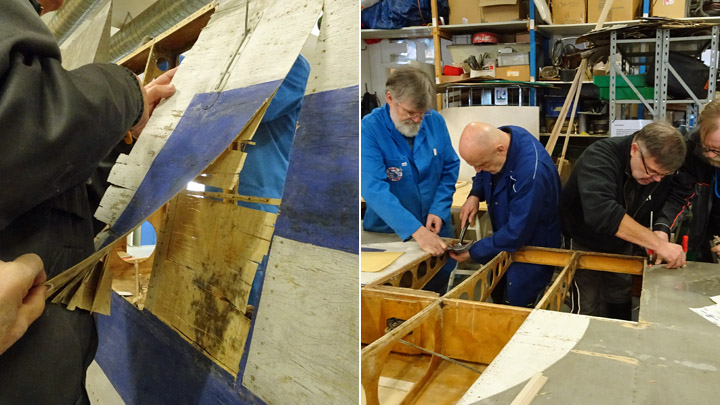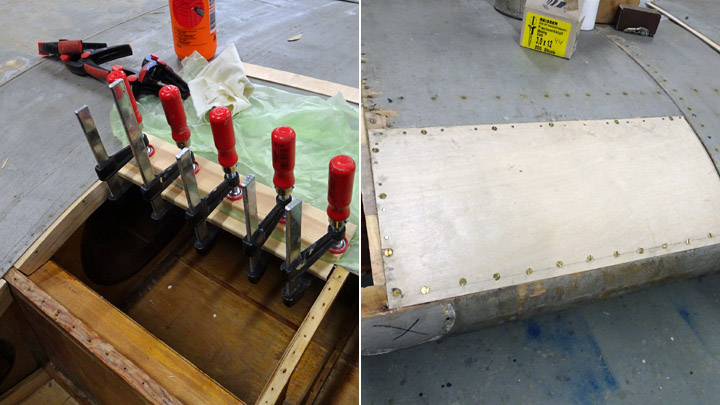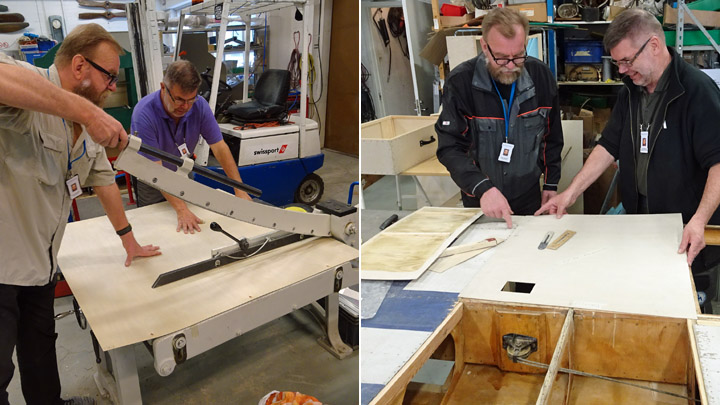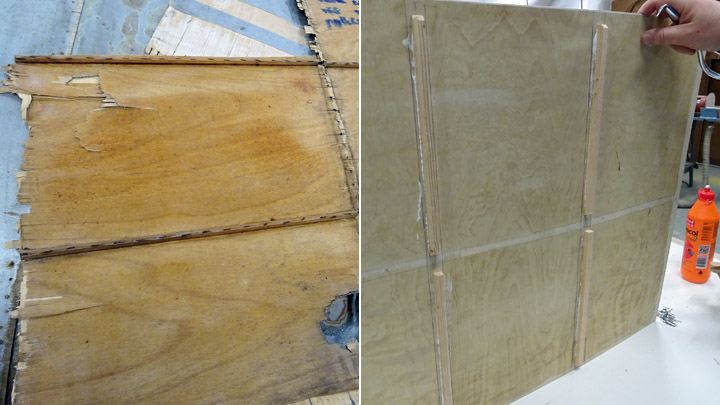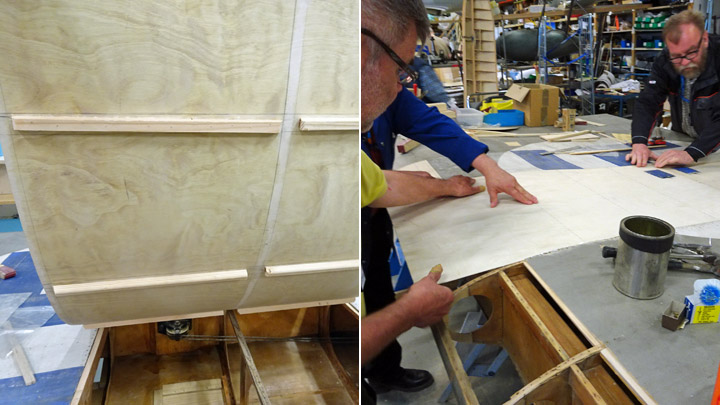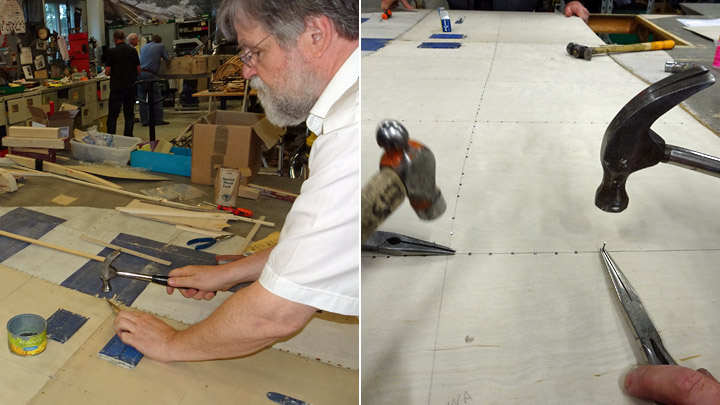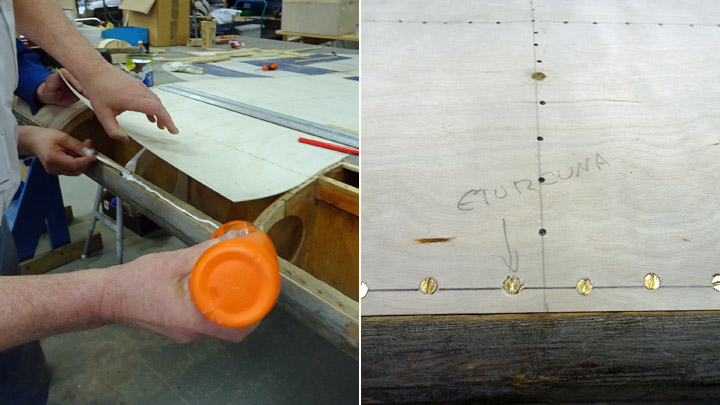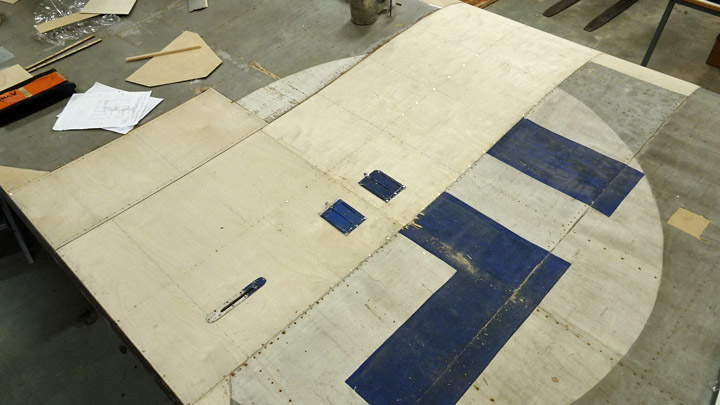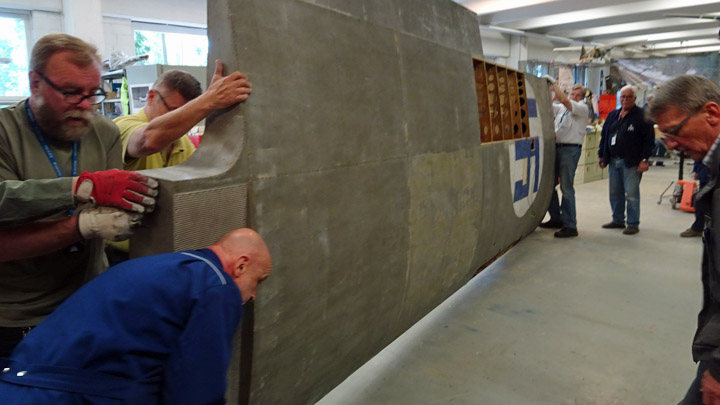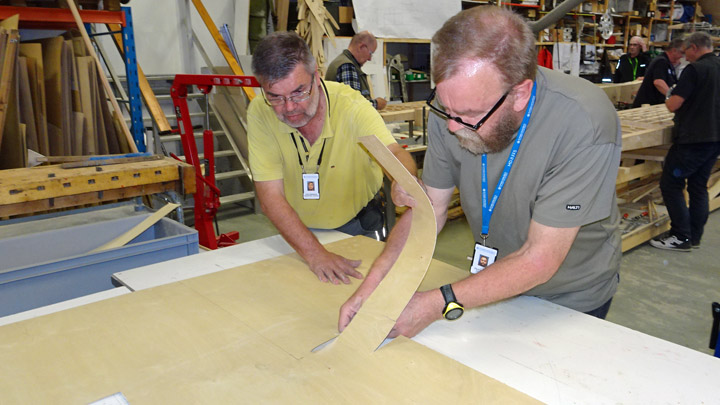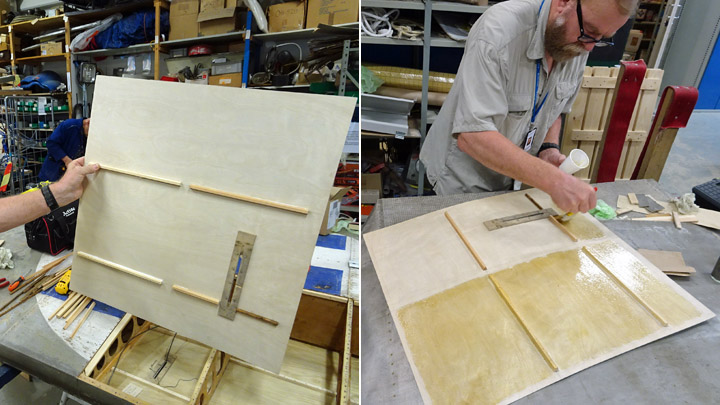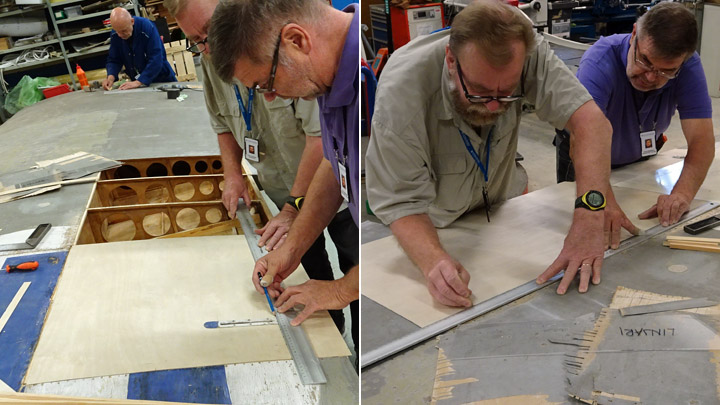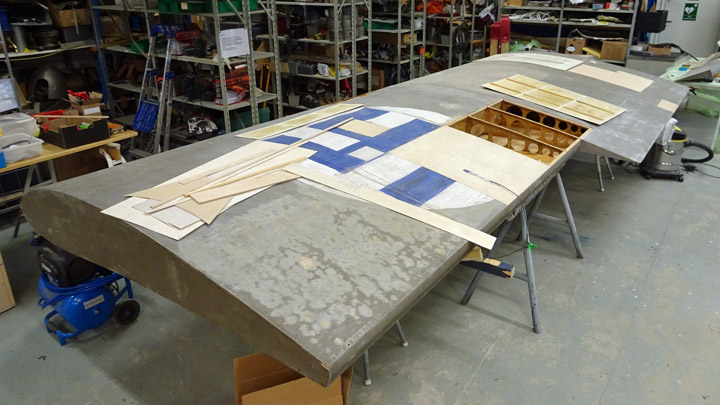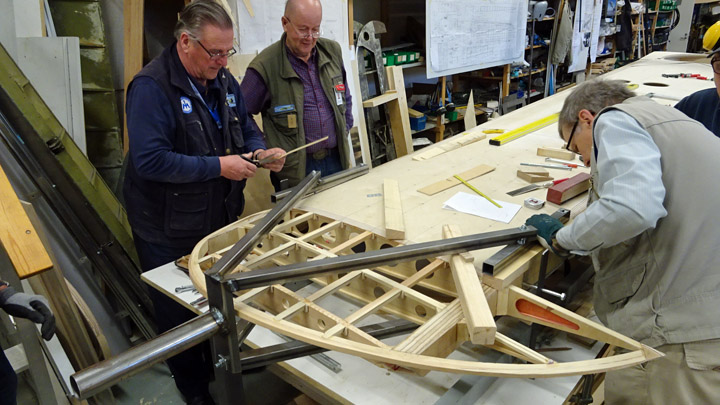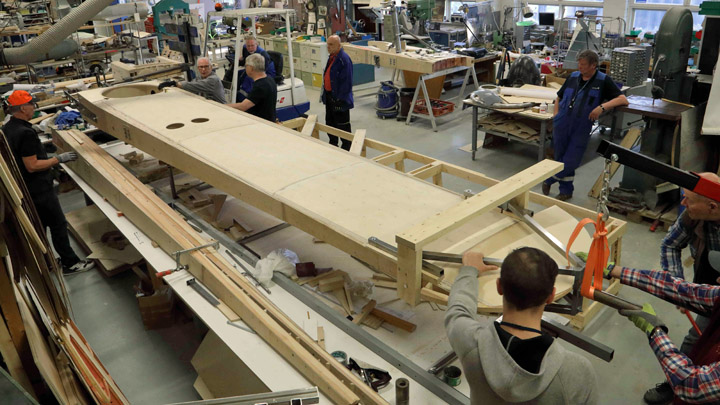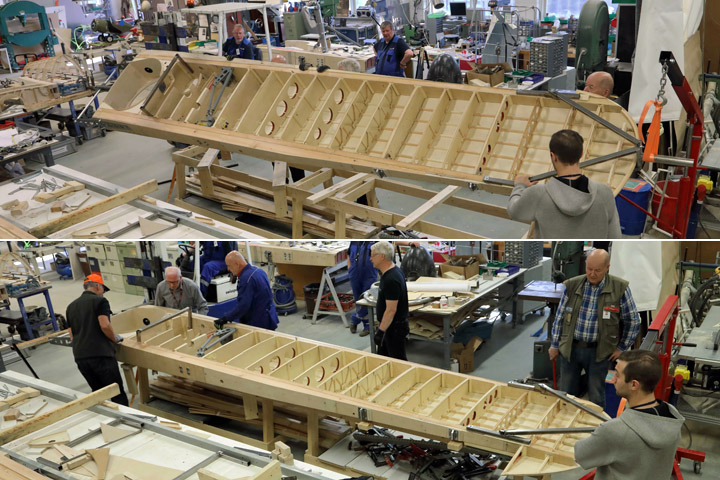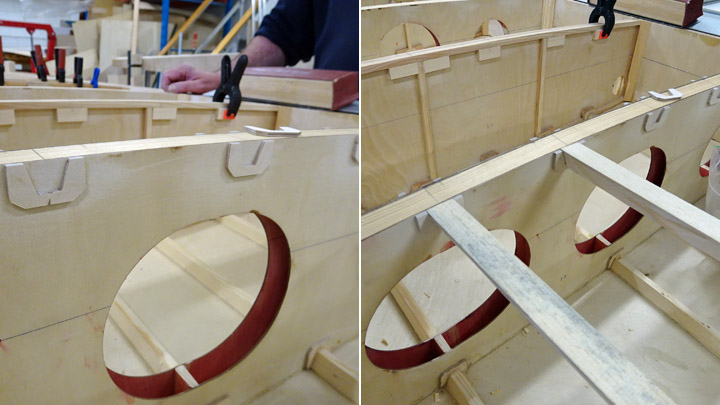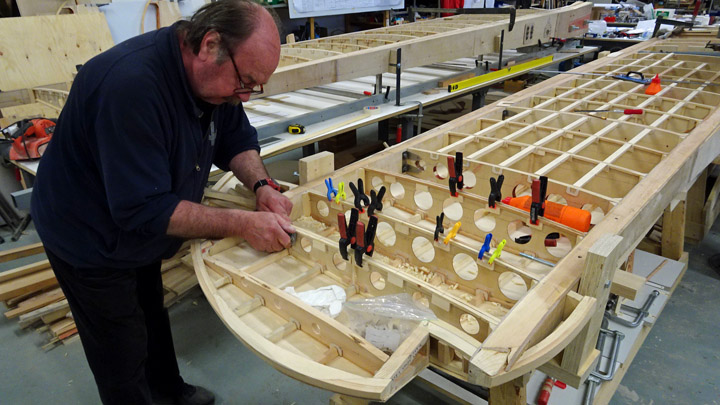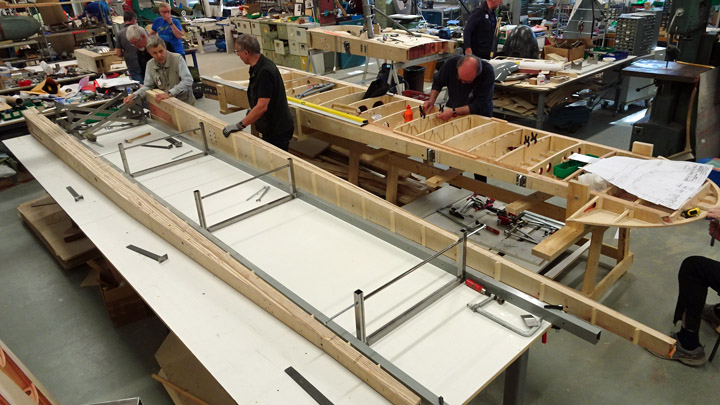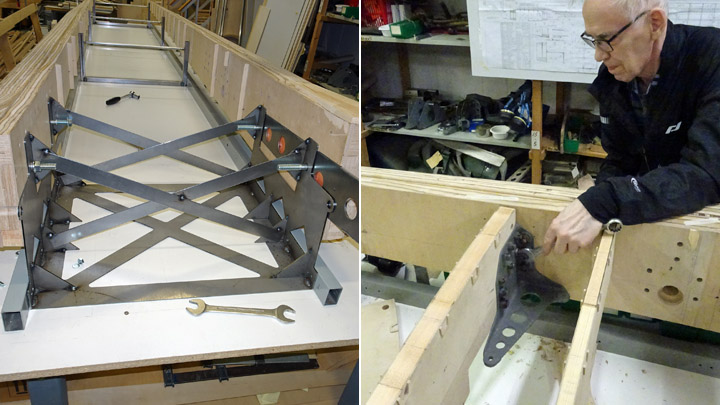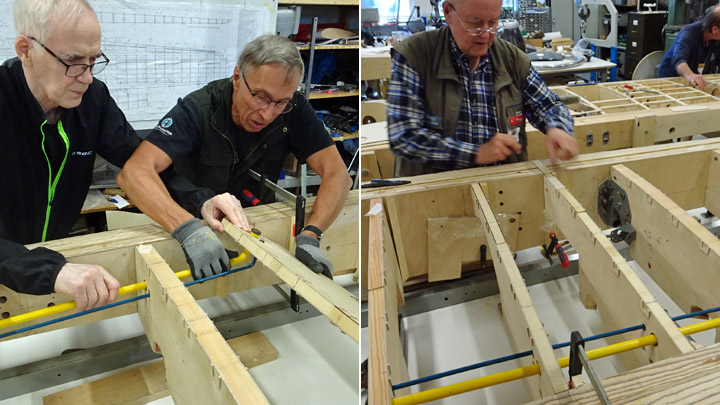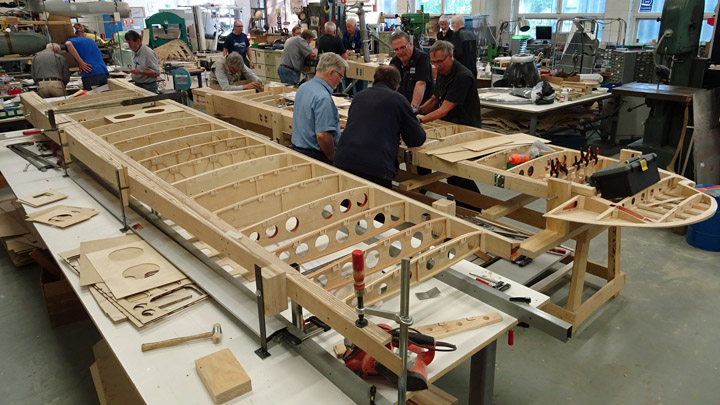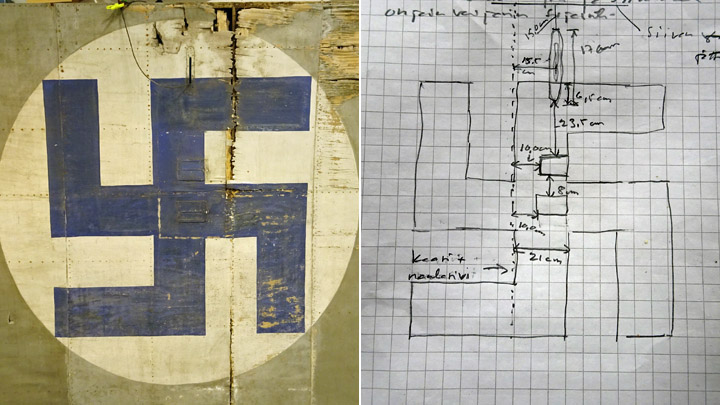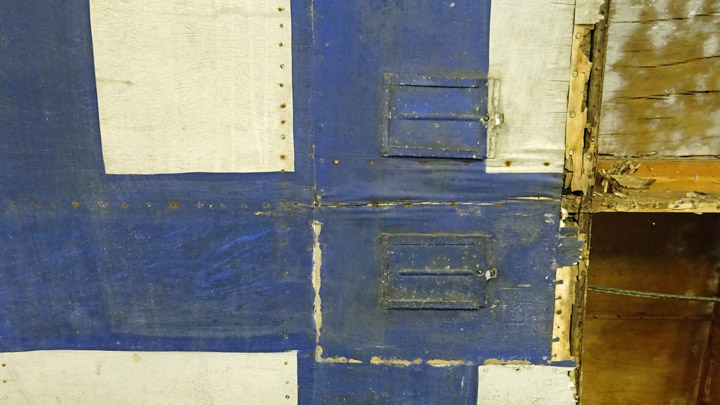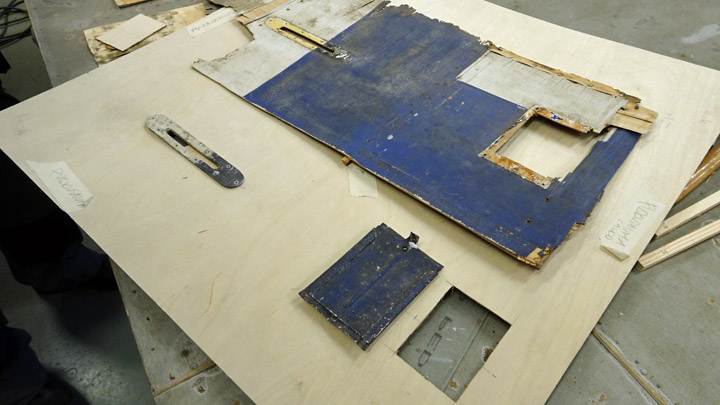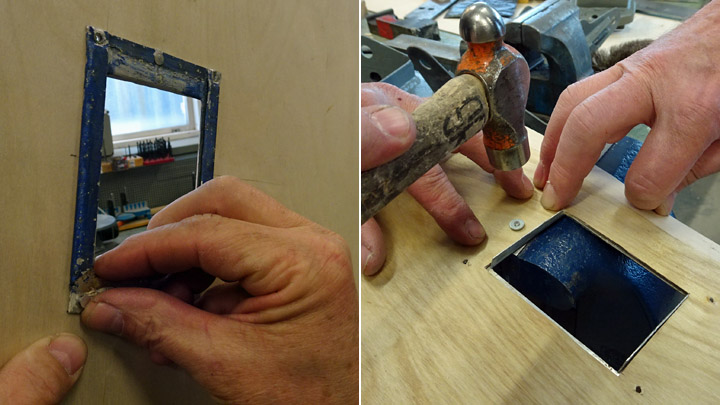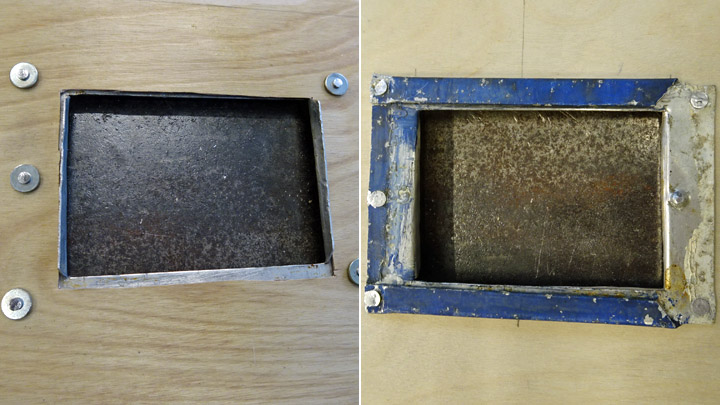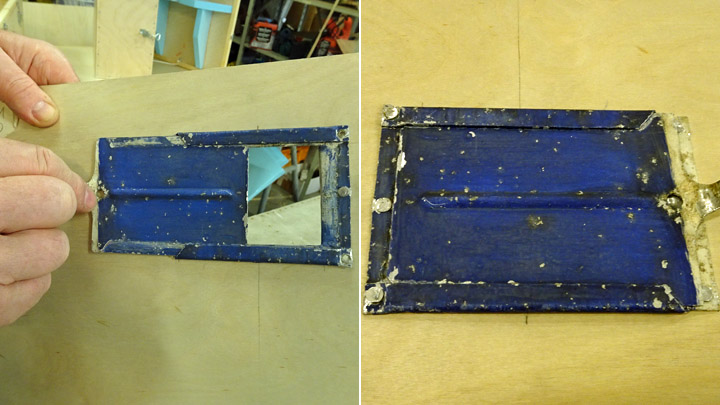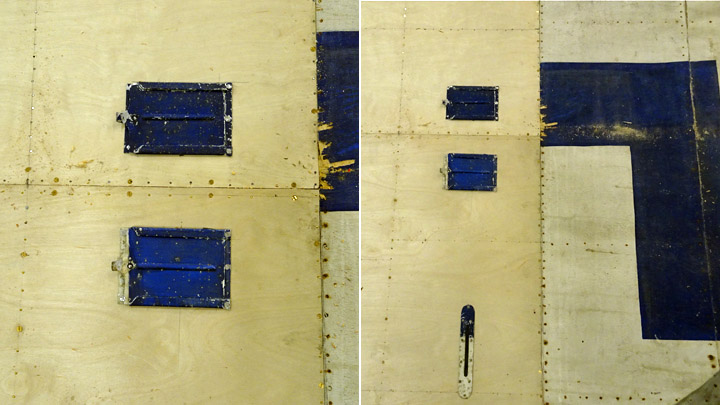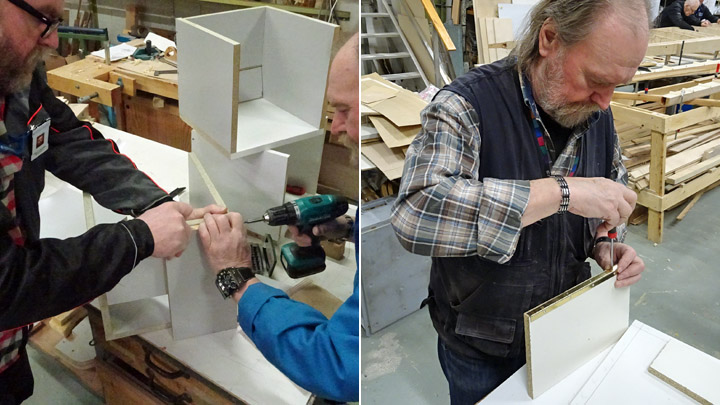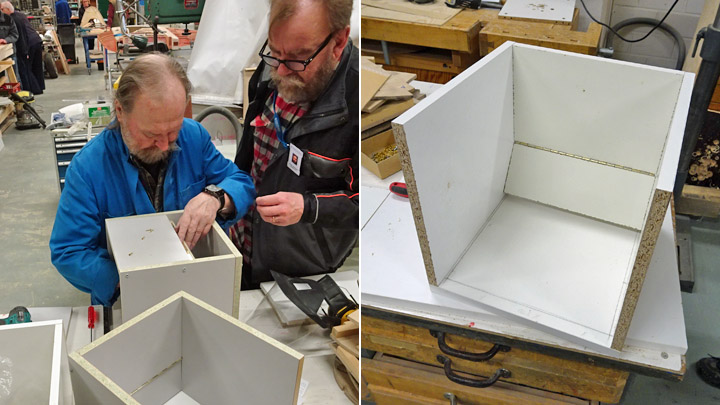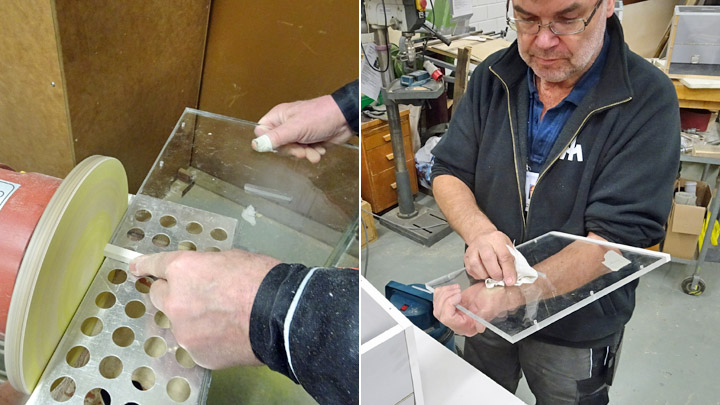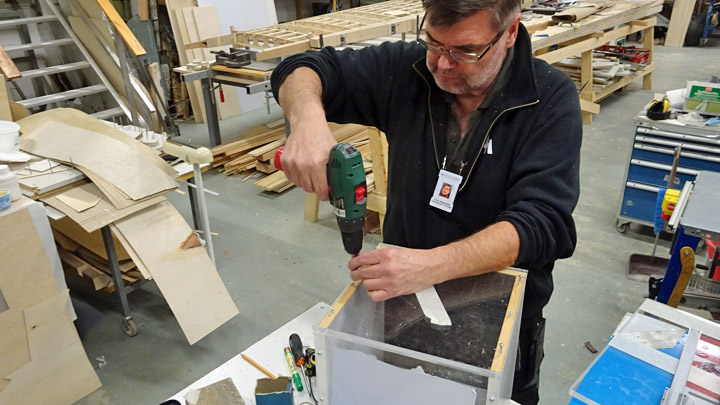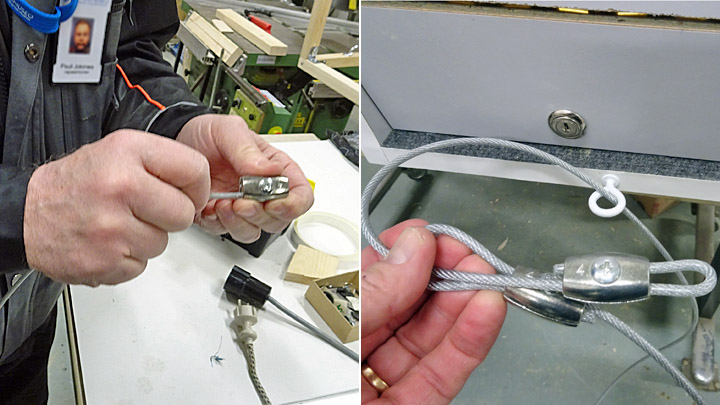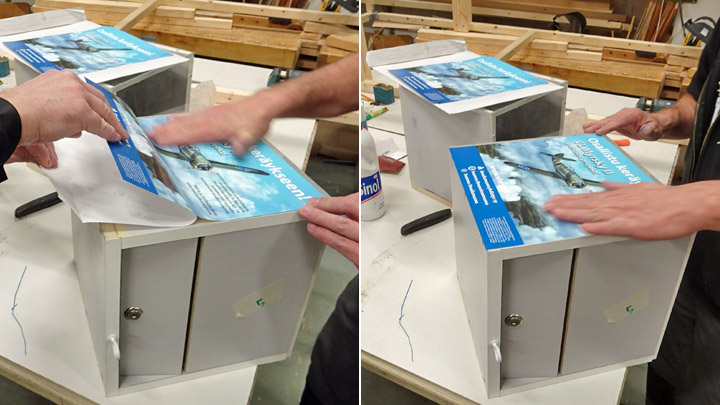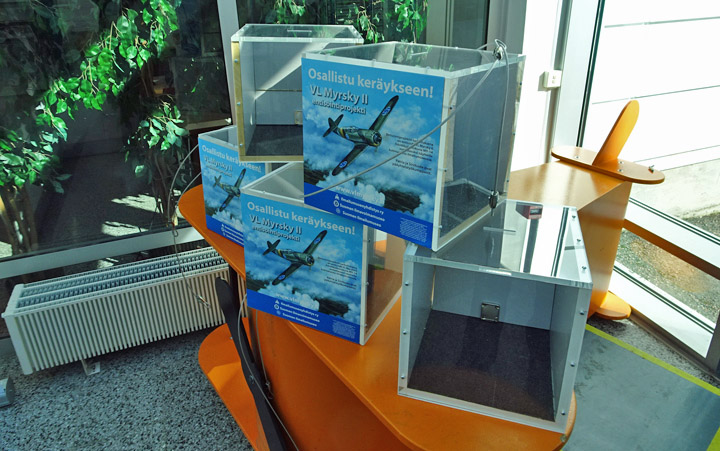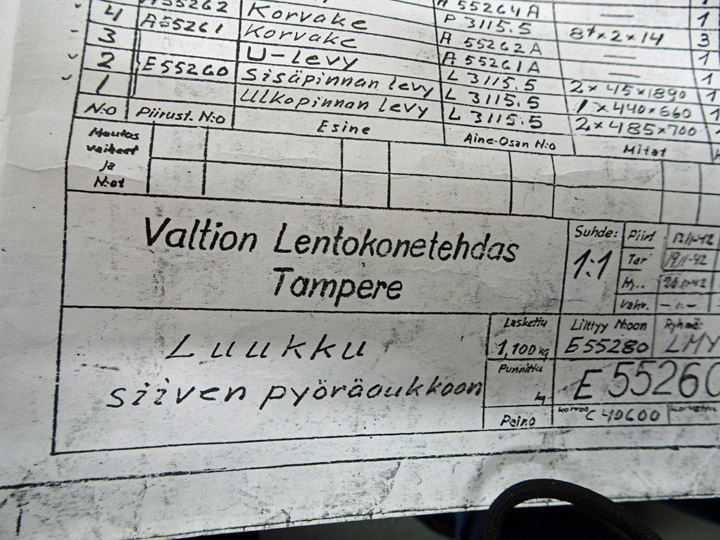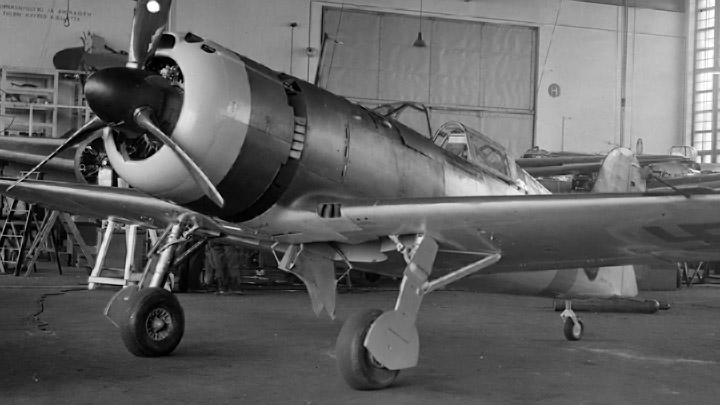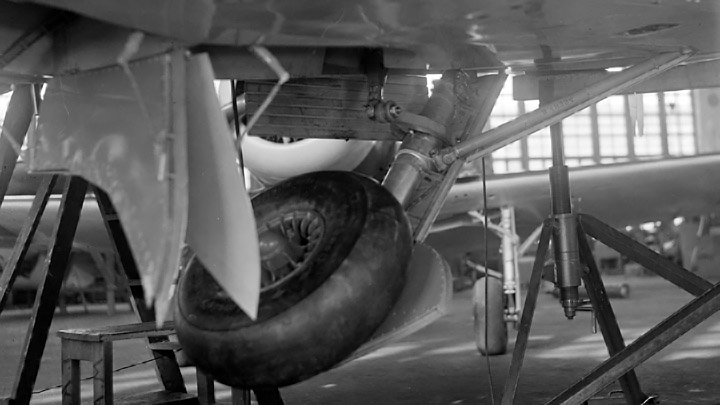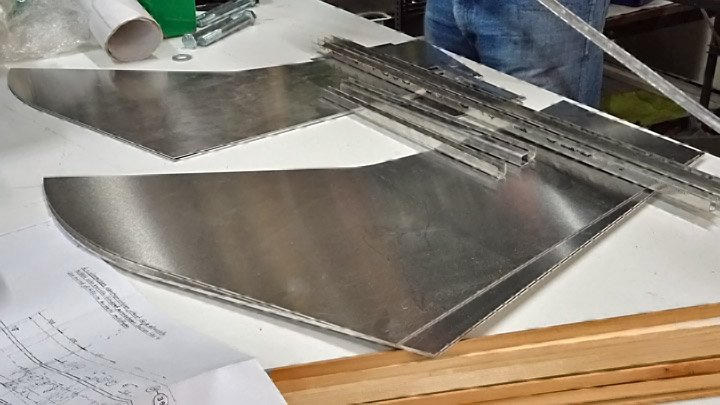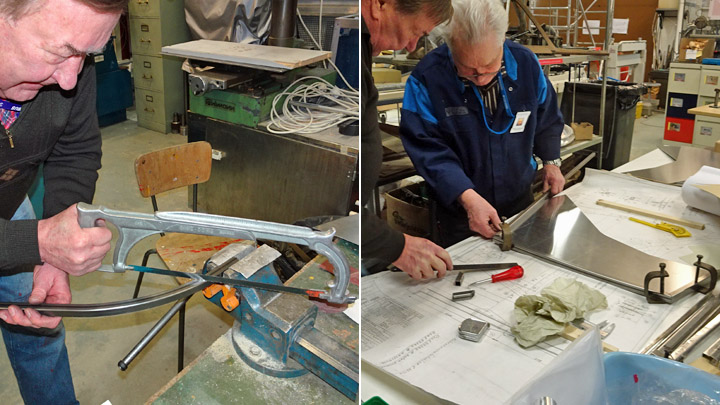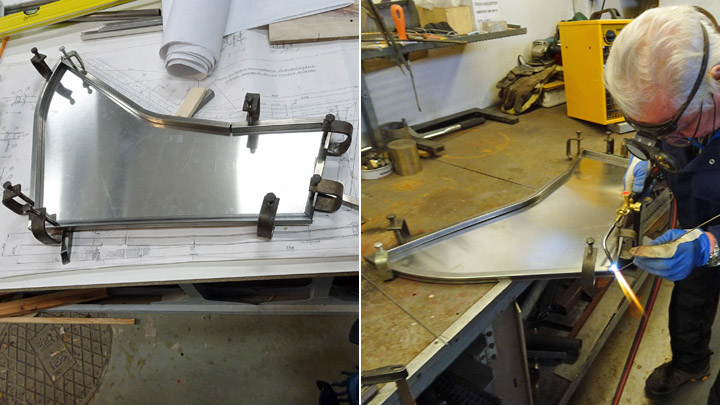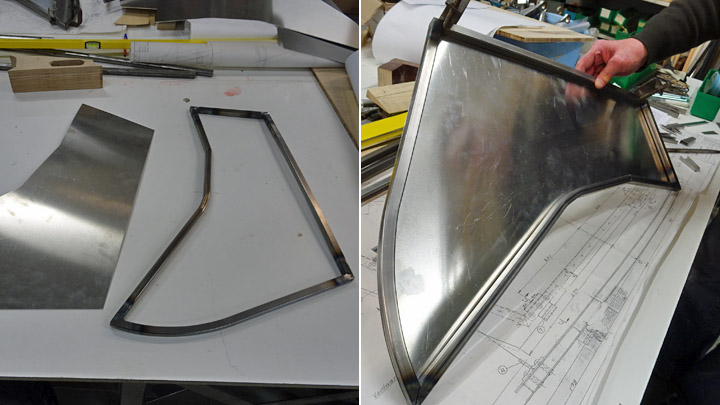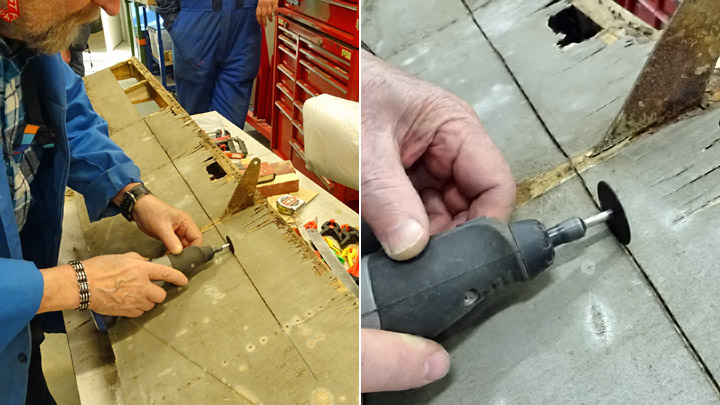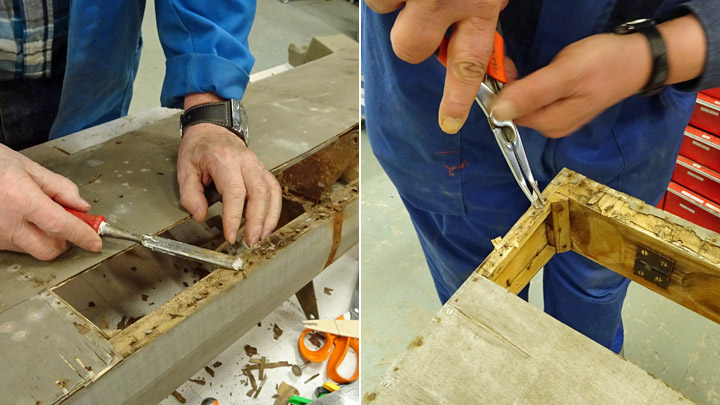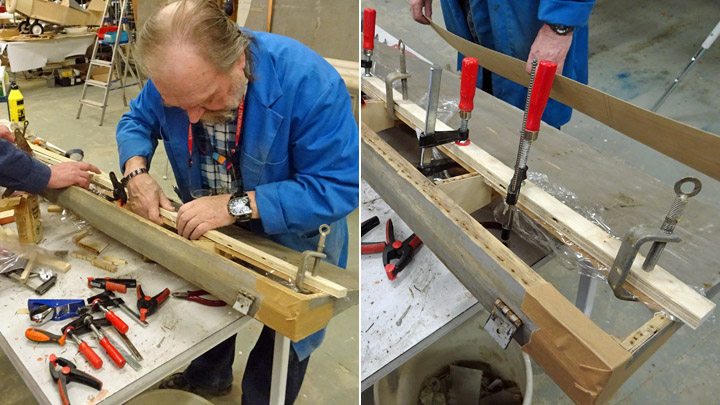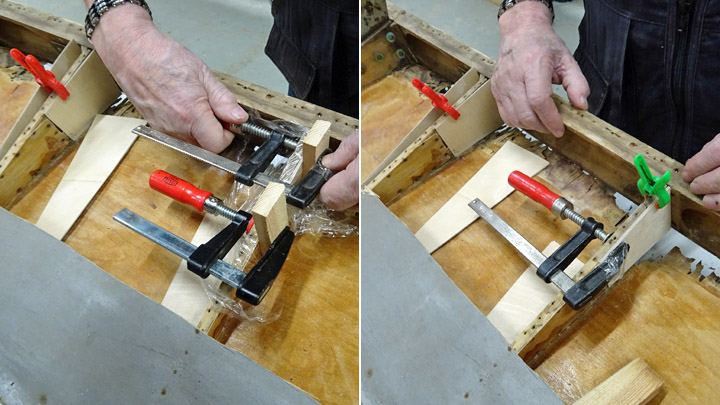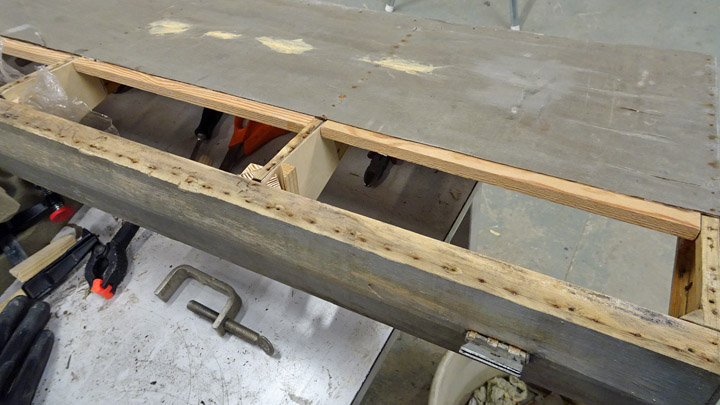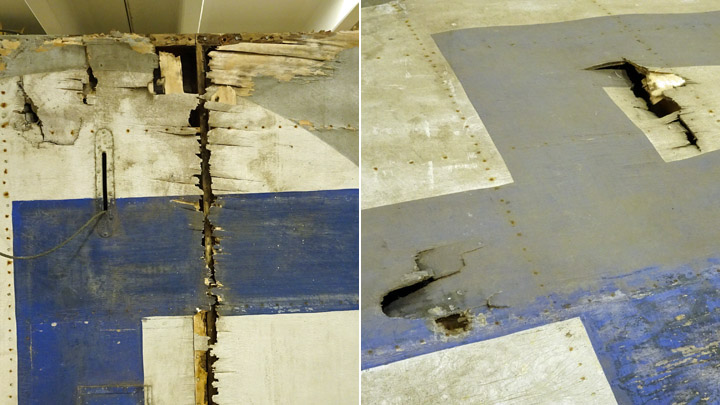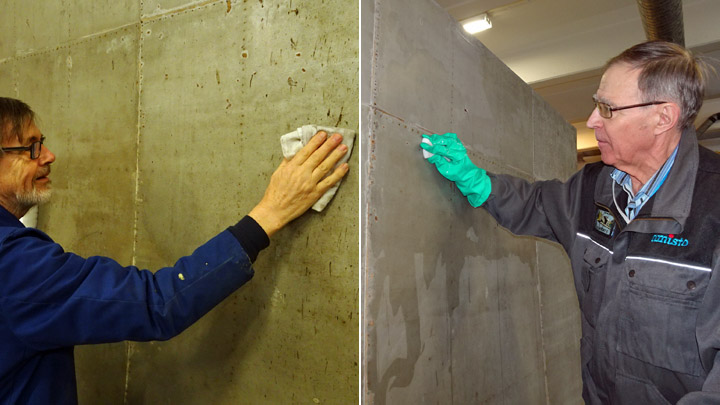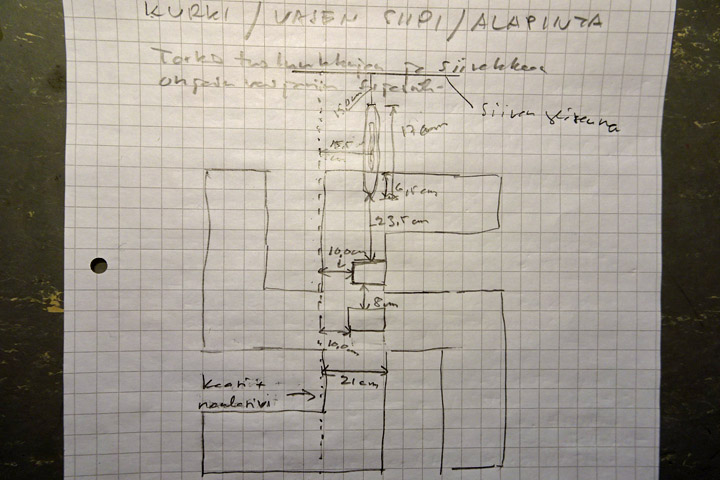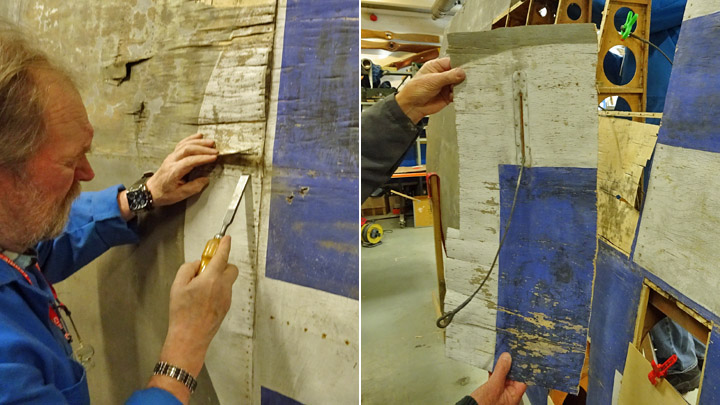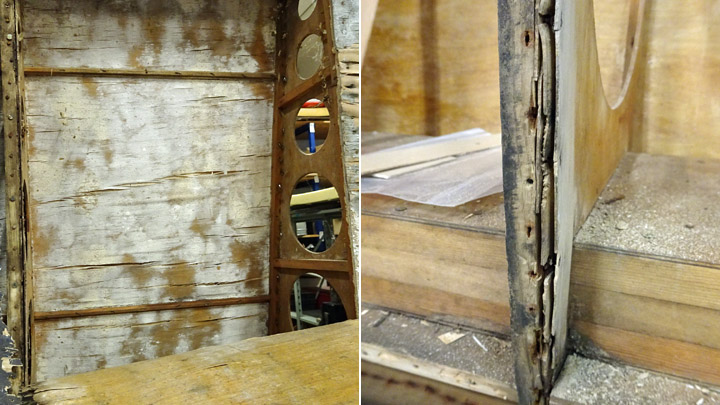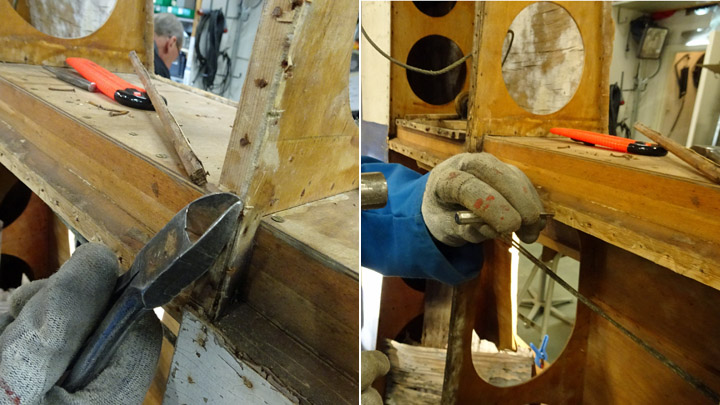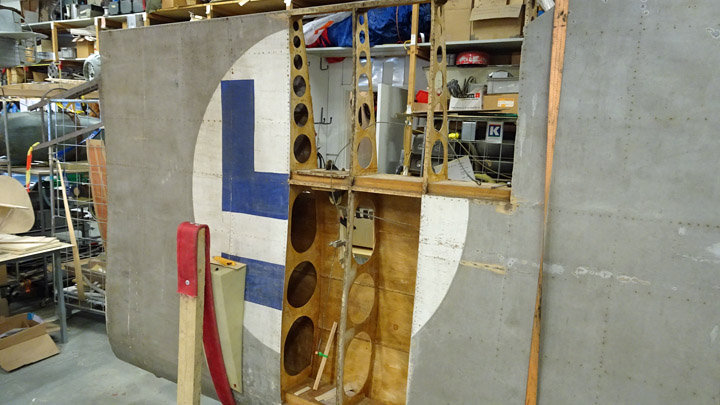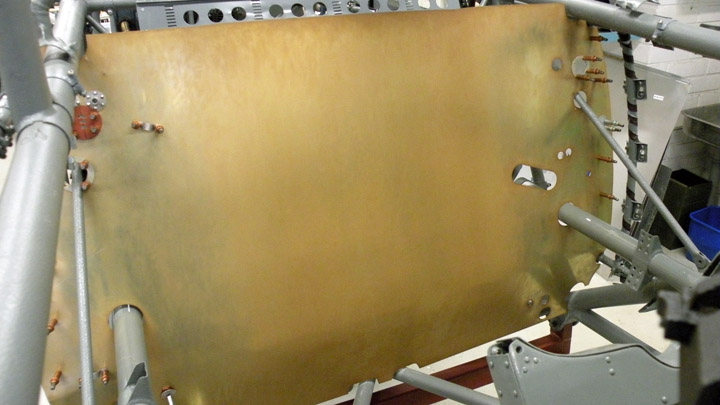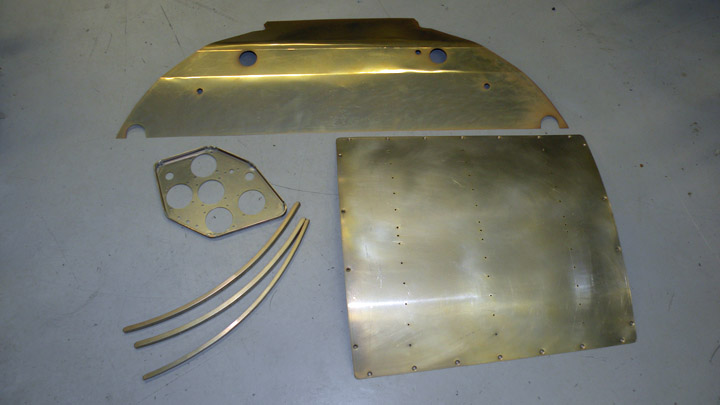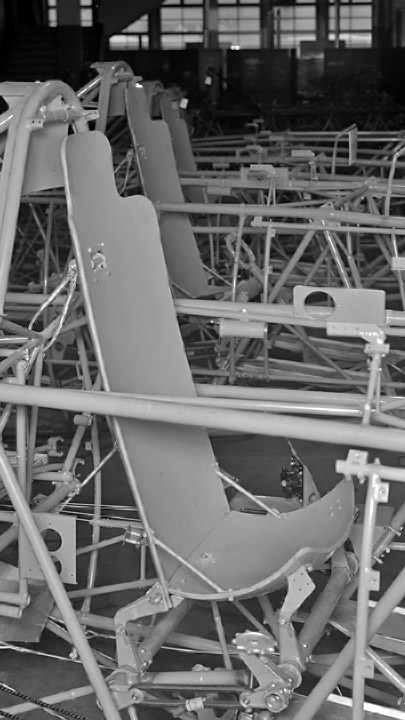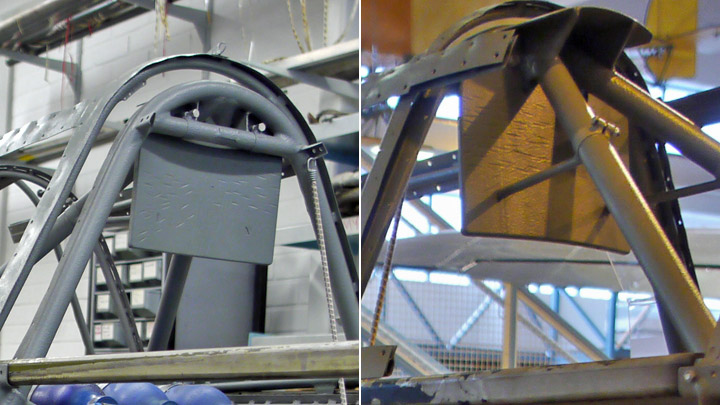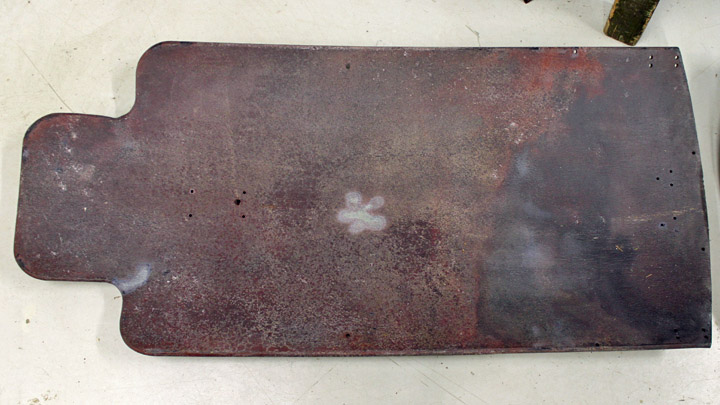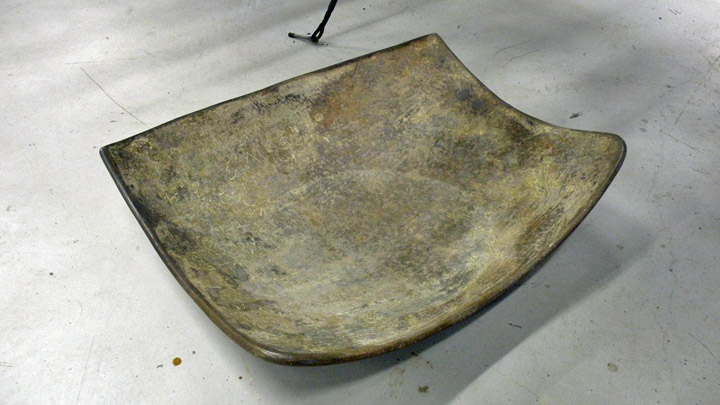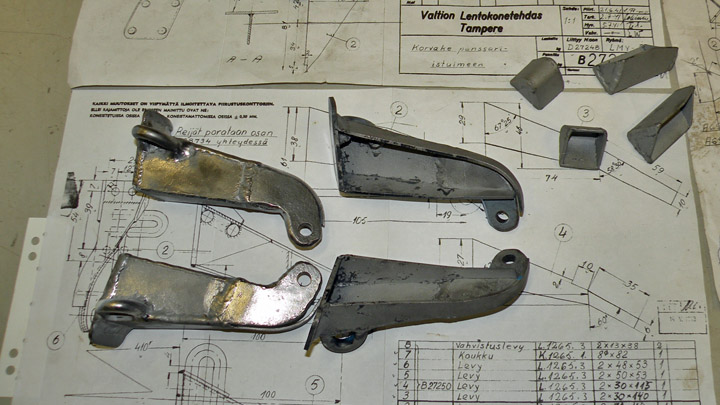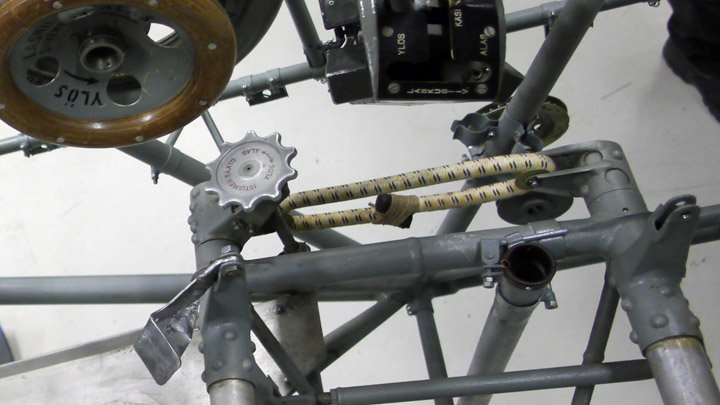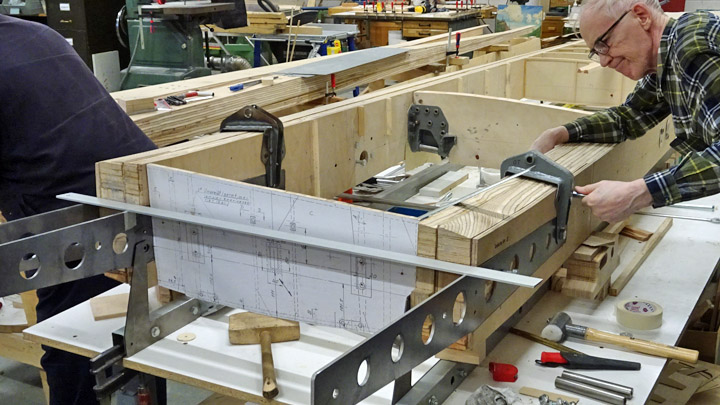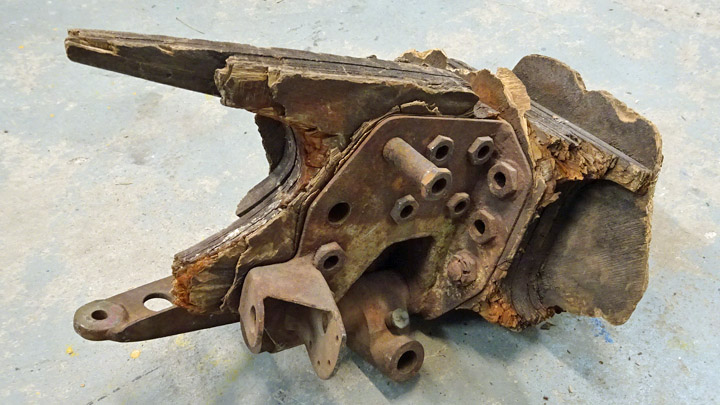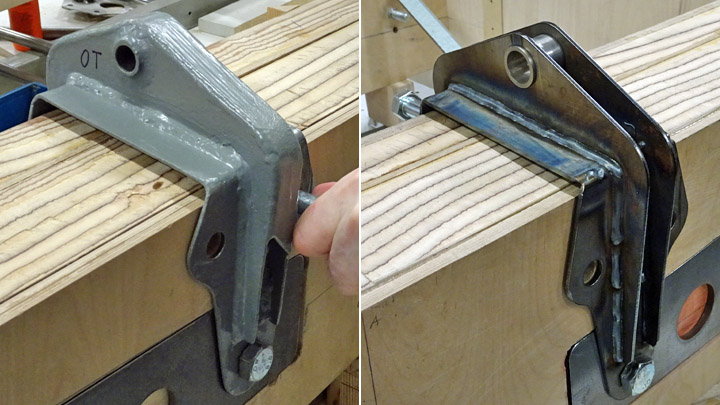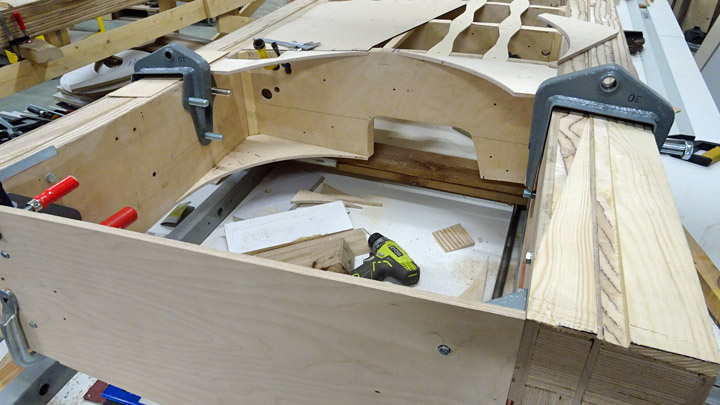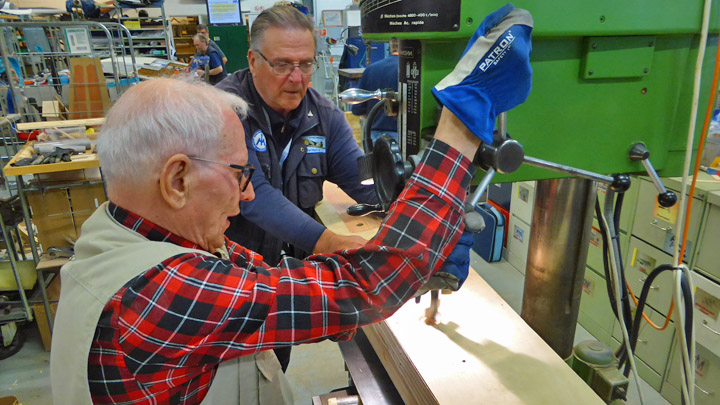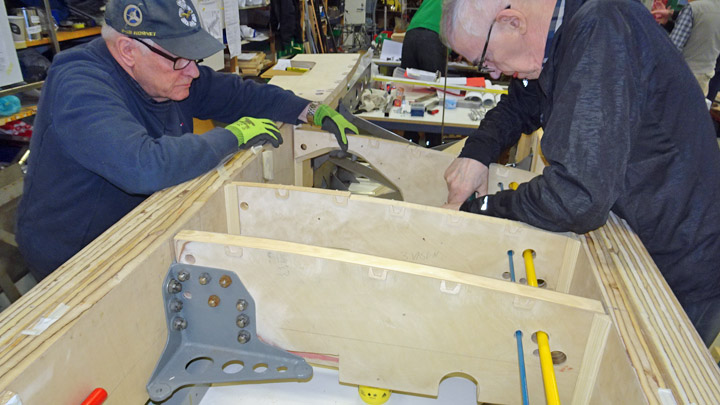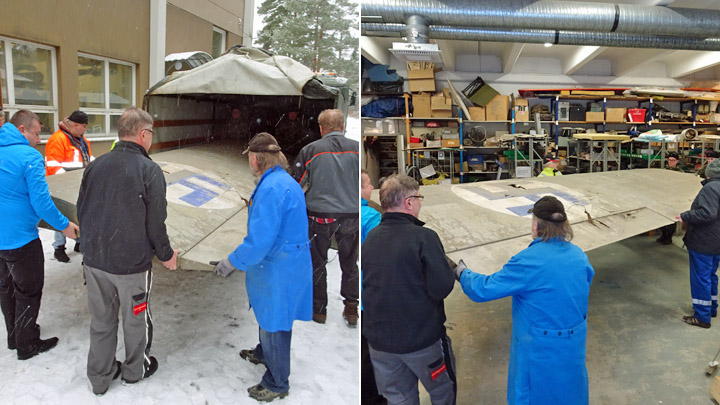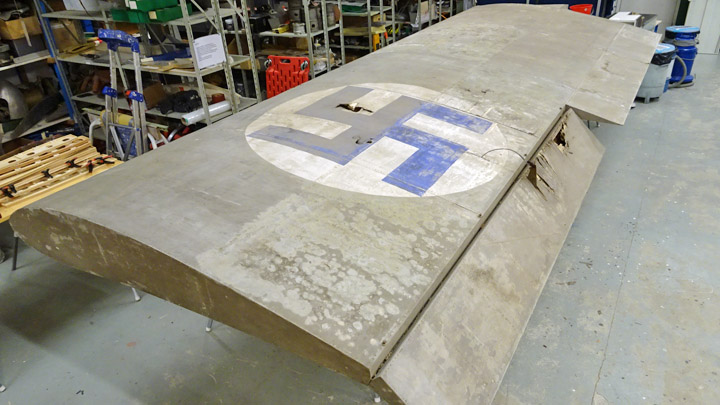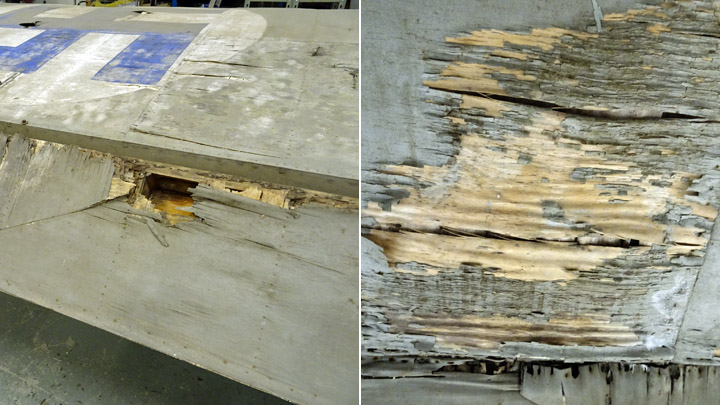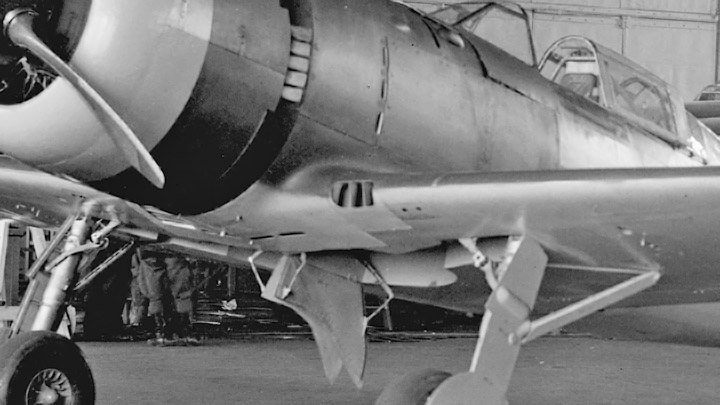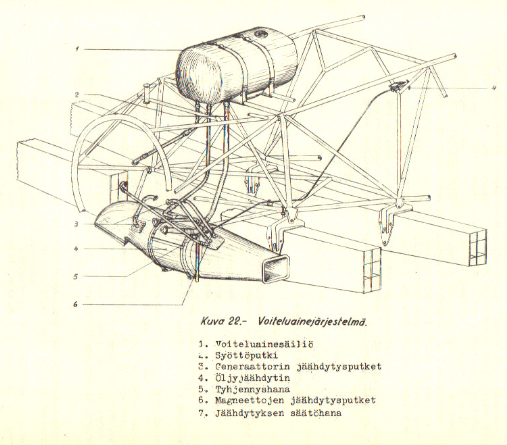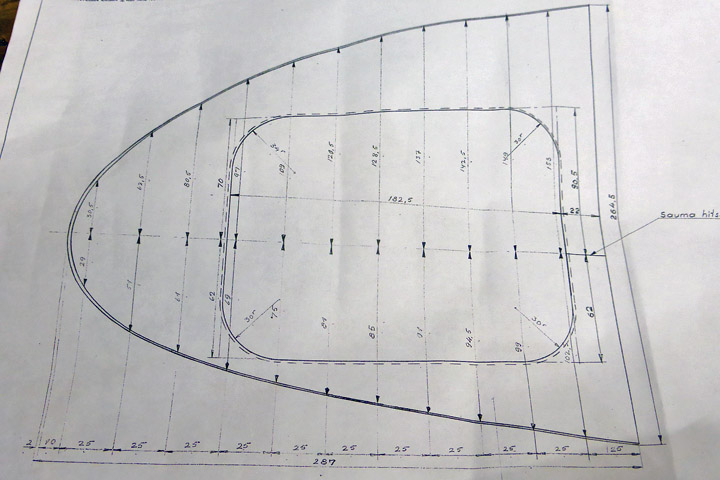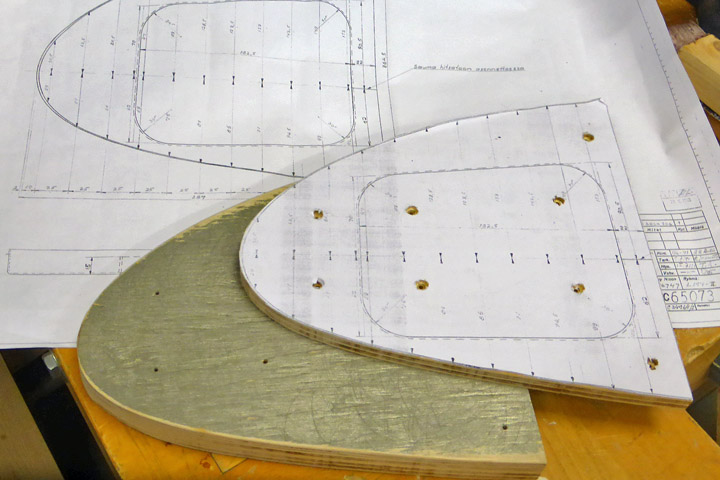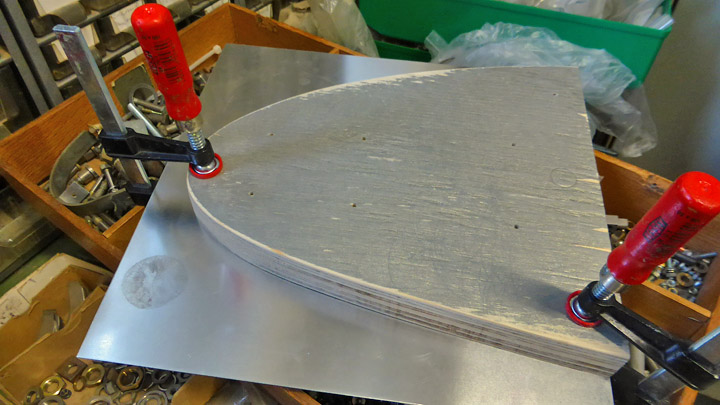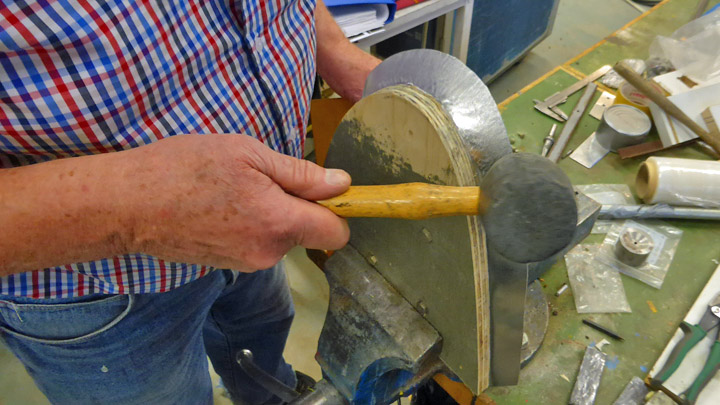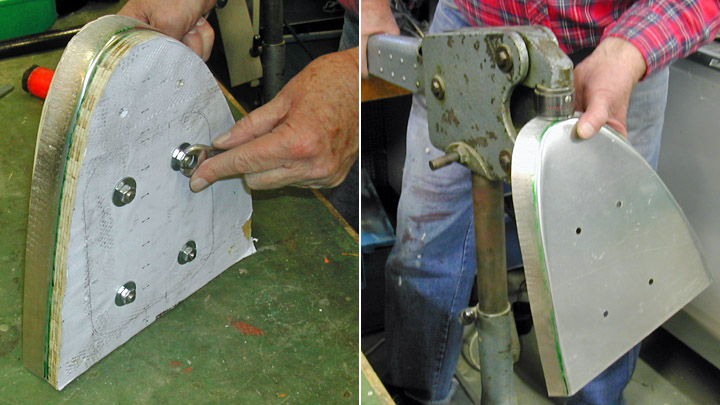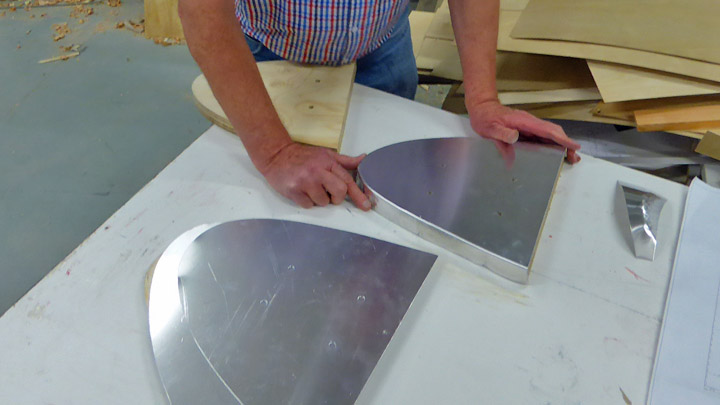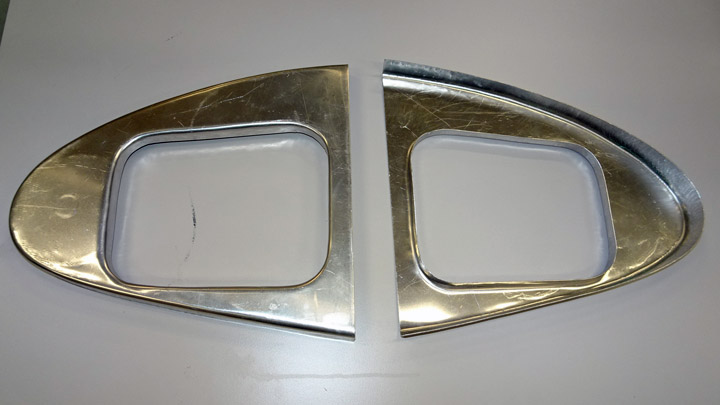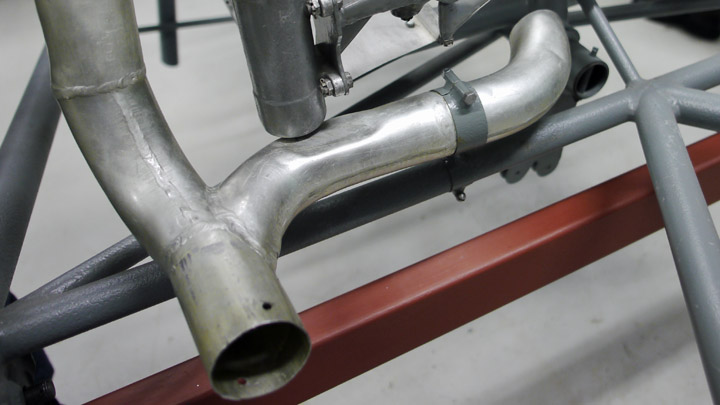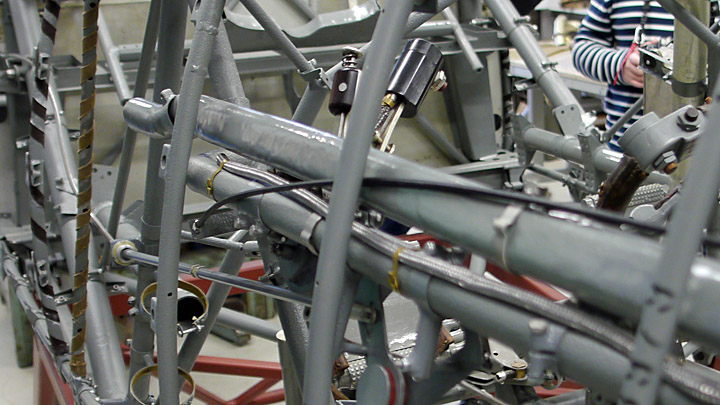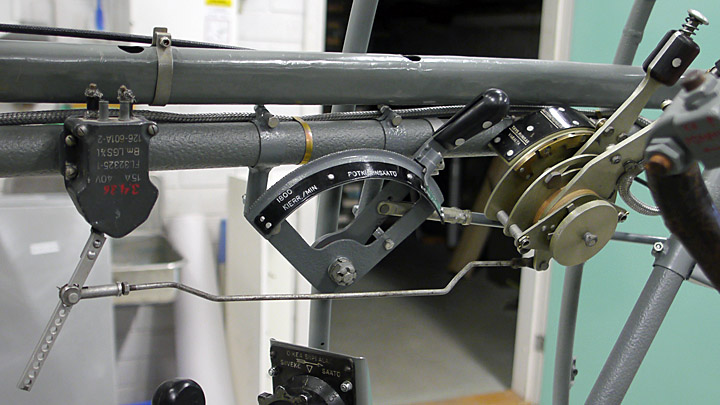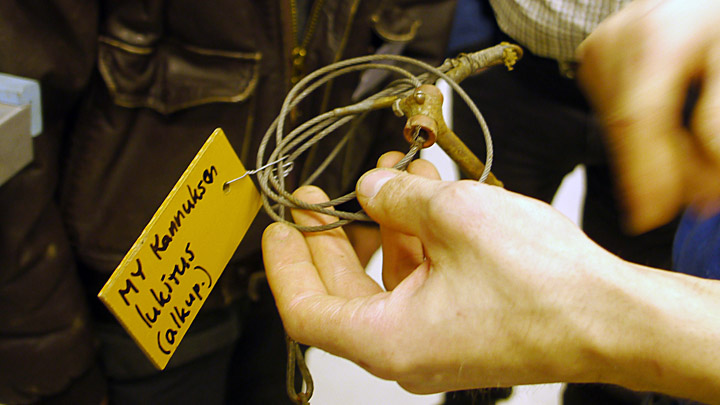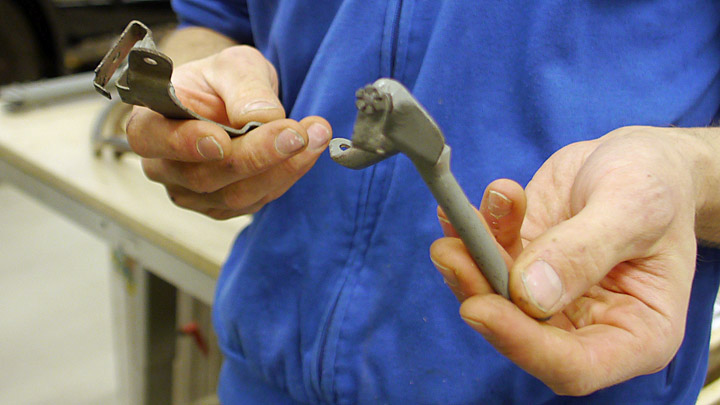Kurki got its venturi tubeMaanantai 26.11.2018 - Member of Tuesday Club The I.V.L. K.1 Kurki was built in 1927 in the Air Force airplane factory at the Viapori sea fortress. The restoration of the Kurki prototype has reached its final phases in the Tuesday Club. One of the last, but not least tasks was to find and install the lost venturi tube on Kurki’s wing strut. The venturi tube is used for indicating the plane’s speed and it is based on the changes in air flow velocity.
The venturi tube has been fastened on the forward wing strut on the right / starboard wing – this can be seen on old photographs of Kurki. On the original wing strut the fastening point of the venturi tube can be seen and also some fastener clips for the air tube leading from the venturi tube to the cockpit.
An old but damaged venturi tube was found at the Finnish Air Force Museum, resembling the old one on the Kurki photograph. The Tuesday Club was pleased of the find, although the stem of the venturi tube had disappeared. Also the round plate at the end of the stem had disappeared, the plate is necessary for fastening the venturi tube on the wing strut. The old venturi tube from the 1920’s is made of cast siluminium, an alloy of zink and aluminium.
The motto of the Tuesday Club says: what is missing, we will make. So without further discussion the club members started making the missing venturi tube stem and fastening plate. The first task was to drill a hole on the venturi tube at the point where the original stem had broken. New nut thread was made for fastening the new stem. The new 15 cm long stem was cut from round aluminium pole, 5,5 mm in diameter. Screw thread was made on both ends of the stem so that it can be fastened on the venturi tube and on the fastening plate.
The fastening plate was made by cutting a piece from 4 mm thick aluminium plate and grinding it round. Holes for fastening screws were made and a hole was drilled in the middle, with nut thread for fastening the venturi tube stem. The sides of the wing strut are slightly curved, the fastening plate of the venturi tube has to be similarly curved. A model of the wing strut was made from stiff steel plate and this was used when hammering the fastening plate into the right curved shape.
Finally the parts of the venturi tube were ready to be fastened to one another. First the stem was screwed into the hole in the venturi tube. Then the fastening plate was screwed onto the other end of the stem so that the end of the stem penetrated the plate and was about 2mm out on the other side. The venturi tube was firmly fastened on a vise by its stem and the end of the stem was hammered flat on the underside of the fastening plate. Now the stem was tightly fastened and locked onto the fastening plate. The final phase was to stamp the year 2018 on the underside of the fastening plate so that the new plate and tube stem can be seen to be different from the original parts of the venturi tube. The venturi tube had now been repaired and was ready to be fastened.
The venturi tube was preliminarily attached on the front wing strut of Kurki’s starboard wing. The tube won’t be fastened before the collar-shaped support made of aluminium plate has been installed around the wing strut. This supporting collar under the venturi tube can be seen on old photographs of Kurki. The covering plywood on the wing strut is only 1,2mm thick so the venturi tube fastening plate and its screws need the additional support of the collar. Photos: Lassi Karivalo. |
|
Avainsanat: aviation history, restoring, old aircraft, I.V.L. K.1 Kurki |
Lower sides of Myrsky's wing tips coveredSunnuntai 11.11.2018 - Member of Tuesday Club The VL Myrsky II (MY-14) is being restored by the Tuesday Club and its wings are nearly ready in the area between the wing spars. The upper sides of the wings have been covered between the spars, but the lower sides are still without plywood covering. The covering won’t be finished before all the equipment, tubes and wires have been installed inside the wing. However, the covering of the lower side of the wing tip could be partly installed. Here the wing tip part means the rounded end of the wing.
The upper side of the wing tip was covered with a single sheet of plywood, stretching over the whole wing tip area. This was possible because the upper surface of the wing tip is arched only in one direction. The lower side of the wing tip arches significantly upwards towards the tip and also sideways. This is the reason why the lower surface of the wing tip can’t be covered using one sheet of plywood: a large sheet can’t be bent properly into two directions.
The solution was to use narrow strips of plywood which are glued together. These strips of plywood can be bent to match the double arching form of the wing tip.
15 cm wide strips of 1,5 mm plywood were cut to match the length of the wing tip. The strips are be glued together using lap joints, so the edges of the strips were beveled (2 cm of the edge), using a mitre grinding machine. Before gluing, the inner surfaces of the strips were protected using polyurethane varnish, tinted red.
The plywood strips were glued into place one by one, starting in the middle of the wing tip. Heavy weights were placed on the strips after gluing. The plywood strips were clamped tightly on the rib and batten structures of the wing.
The whole lower side of the wing could not yet be covered because the navigation light wiring, etc. has to be installed inside the wing. The covering of the lower side of the wings has been started: three strips of plywood have been glued into place on both wings. |
|
Avainsanat: aviation history, restoring, old aircraft, VL Myrsky II, MY-14 |
MY-14 got windscreenPerjantai 9.11.2018 - Reino Myllymäki Perspex or acryl or PMMA was found in the beginning of the 1930s. It got a tradename Plexiglas in Germany and Perspex in U.K. These tradenames led to generic name pleksi (in Finnish) or perspex (in English). Nowadays these generic names mean later innovations like polycarbonat (PC), too.
The VL Myrsky II restoration project has a windcreen already glazed with green frames. This item has been shown in several exhibitions. It is a spare part never used in any Myrskys. It might be installed to another aircraft and little changed. Therefore it won't be installed to the MY-14.
The restoration team of the Finnish Air Force Museum used another windscreen for the MY-14. The windscreen has four perspex plates: one arched and three straight plates. The arched plate is original and it was smoothed. The straight plates were disappeared and the team made new ones. The plate edges have rabbets so that the plate will be on the same level with the frame. The rabbets were made by a rabbet cutter.
The installation of the strainght perspex plates was the first stage, then the arched plates will be taken under construction. There were arched perspex plates in the windscreen, canopy and aft glazing. The installation of the gun sight is under construction, too.
During the arrangement of the storage, the Myrsky's weapons were taken to wait the installation. There is two 12,7 mm LKk/42 heavy machine guns of VL Myrsky and six 12,7 mm Breda-SAFAT heavy machine guns of Fiat G.50 in same box in the photo. |
|
Avainsanat: aviation history, restoring, old aircraft, VL Myrsky II, MY-14 |
Wheel well cover of Myrsky?s test wing installedSunnuntai 4.11.2018 - Member of Tuesday Club The wheel well covers for VL Myrsky II (MY-14) wings have been under construction since spring. Three covers will be made: two for the actual Myrsky and one for the test wing.
The wheel well cover consists of two sheets of aluminium and a supporting frame in between, made of 15mm steel tubes. The aluminium sheet on the inside is slightly smaller than the outer sheet. Rivets are used to attach the aluminium sheets to the supporting structure so that the cover forms a box construction. The wheel well cover is attached to the edge of the wheel well with two hinges. The hinges are fastened on the edge of the steel tube structure of the cover.
During this autumn the wheel well cover for the test wing has been under construction. The assembly of the wheel well cover, and the function of the hinges will be tested on the test wing before making the covers for the actual Myrsky wings.
The steel tube structure was made first, then the hinges were welded on the frame and then the cover structure was assembled into the wheel well hole. The hinges were fastened to the edge of the wheel well to see how the cover fits and functions. Several modifications were needed, and the position of the hinges had to be changed before the assembly team was happy with the result. When the correct position of the hinges on the tube frame had been found, the aluminium plates could be riveted on the frame.
The aluminium plates and the tube structure were clamped together, into a tight package. Holes for the flush rivets were drilled along the edges of the cover so that the drill penetrated both aluminium sheets and the tube construction between them. The holes are about 4cm apart and their edges were bevelled with a drill so that the rivet tops will be at the same level as the aluminium sheet top.
Before riveting the aluminium sheets were sent to be chromed. Chroming forms a thin organic layer on the surface of the aluminium and protects it from oxidation. The chromed surface is an excellent foundation for painting work. The chroming was not done by the Tuesday Club.
When the chroming had been done, riveting could be started. 20mm long flush rivets were used. A pneumatic riveting hammer was used when placing the rivets one by one into the holes on the wheel well cover. No problems occurred during the riveting work and the aluminium sheets and the steel tube frame soon formed a box construction. The cover could be fastened on the edge of the wheel well by installing the hinges. When the cover was closed, it fitted tightly into the wheel well opening.
The next step in the restoration work will be to assemble a spring mechanism into the wheel well under the cover. This mechanism will push the cover open when the landing gear is taken out. A lever will be installed on the inside of the cover to close the cover. When the landing gear is pulled in, the wheel of the gear will push the lever and the wheel well cover closes. |
|
Avainsanat: aviation history, restoring, old aircraft, VL Myrsky II, MY-14 |
Ongoing activites at Myrsky wingtipSunnuntai 28.10.2018 - Member of Tuesday Club In the restoration work of VL Myrsky II the installation of the navigation lights is under way. When the tip of the wing was built, a gap was left on the front corner of the wing so that the navigation lights could be installed later.
The navigation light on the wingtip consists of a transparent aerodynamically designed plexiglass cover and its frame, made of aluminium, which attaches the cover onto the wing structure. The actual navigation light bulb is inside the cover, surrounded by a small red or green plastic cover.
The plexiglass cover of the navigation light is made in a vacuum moulding machine. The heated 2mm pvc plexiglass plate is pressed on a mould which has the shape of the navigation light cover. When the plexiglass has cooled on the mould, it is cut into shape.
The mould for the navigation light cover was made from wood. Pieces of wood were glued together to form a piece large enough for the moulds of the navigation light covers on both wings. The piece of wood was cut and milled following drawings so that it had the shape of two navigation light covers, back to back. When the desired shape had been reached, the piece was cut into two parts. Now the moulds for the two light covers were ready.
The cover is assembled into the gap at the wingtip using a frame made of aluminium sheet. For the making of the frame a mould is needed, following the shape of the plexiglass cover. The aluminium frame is made of two halves, upper and lower, which are welded together around the mould. Also in this case the mould was made from wood, matching the shape of the navigation light cover.
The upper and lower halves of the aluminium frame were screwed onto the wooden mould and the ends of the two halves met correctly. A piece of copper tube was placed under the ends of the frame halves to protect the mould from excessive heat when welding the parts together. The tube also forms a solid base under the frame edges when the welding is done.
Some additional work is still required before the navigation light cover mould is ready: it needs a supporting structure before it can be attached to the vacuum moulding machine. The mould for the aluminium frame is ready and the halves can be welded together to form the frame. |
|
Avainsanat: aviation history, restoring, old aircraft, VL Myrsky II, MY-14 |
Tuuli III parts are registered and packed for relocationTorstai 18.10.2018 - Member of Tuesday Club The Finnish Aviation Museum is planning to move into new premises located in the former Finnair cargo terminal, close to the T1 terminal of Helsinki-Vantaa airport. For the future relocation of the collection, the Finnish Aviation Museum gave instructions to the Tuesday Club to begin the registration and packing of collection items so that the parts will remain in control and proper order during the move. The first target were the parts dismantled from Valmet Tuuli III, which is being repainted at the Tavastia Vocational College in Hämeenlinna. Some dismantled parts have been waiting for its return on the shelves of the restoration space, marked with plywood identification tags.
It has been agreed that Tuuli III itself will stay in Hämeenlinna during the museum’s relocation and it will be brought back for further restoration after a couple of years. The dismantled Tuuli III parts are being used to test the registration and packing procedure developed for moving the aircraft parts of the Aviation Museum.
The Finnish Aviation Museum (Antti Laukkanen and Matias Laitinen) developed a multivariate Excel-table, into which all the labelled aircraft parts or part groups are carefully registered. After registration the parts will be packed, numbered and stored on traversers to wait for the relocation.
The Tuesday Club has been working on the registration and packing for two days and the experiences gained on the Excel-table have been positive. The registration sheet and the packing procedure are efficient, and the instructions are clear. It took the team two Tuesdays to classify and register a couple of dozen parts or part groups. However, some time was needed to learn to use the Excel-tool. An immense task is ahead when the thousands or tens of thousands of items in the Aviation Museum’s collections will be registered, numbered and packed for the move. |
|
Avainsanat: aviation history, restoring, old aircraft, Valmet Tuuli III |
New plywood surfaces of Kurki wings and wing struts paintedTiistai 9.10.2018 - Member of Tuesday Club The restoration work of I.V.L.K.1 Kurki has been almost completed at the Tuesday Club. The painting work of the partly replaced plywood areas on Kurki’s wings and of the new and repaired plywood surfaces on its wing struts remains to be completed. On both wings several square meters of rotten plywood had to be dismantled, mainly around the national emblems. Now the new covering areas are painted using a method similar to the original one.
First the new plywood areas had to be buffed out to remove the “lint” on the surfaces. The plywood surface was moistened using a spray bottle and dried using a heater fan, to make the “lint” stand upright. Then the surface was buffed out using 320 sand paper.
This procedure was repeated several times so that the plywood surface became very smooth. Chemical wood was used to putty the seams between the new and the original plywood sheets, then the seams were honed. Finally, the plywood surfaces were vacuumed and cleaned with a damp cloth, dipped in a solution containing 50 % Sinol and 50 % water.
Some expert advice for the Kurki wing painting was provided by the surface finishing teacher of the Tavastia Vocational College. A brief painting course took place at the Finnish Aviation Museum and the wings of Kurki were used as an example when discussing the treatment of new plywood surfaces and the painting work itself.
One of the key issues in successful painting is to keep dust away from the painting room and the surfaces which are being painted. After the wings had been vacuumed, they were covered using a thin film of plastic, which was cut open at the areas to be painted. On the edges of the painting areas the plastic film was taped tightly onto the surfaces.
The plywood surfaces of Kurki had originally been painted by first applying clear varnish on the clean plywood. On top of that a varnish tinted with silver bronze colour pigment was applied, and finally a layer of clear varnish added on top. A similar method is being used in the restoration work. Instead of clear varnish a corresponding modern material is used: La Tonkinois -lacquer, which is a mixture of varnish and Japan tree oil.
Before the Le Tonkinois-lacquer can be applied on the surface, the amount needed has to be filtered, in order to remove possible “bits and nuggets” in the lacquer. Then a clear base layer of Le Tonkinois was applied on the new and clean plywood surfaces on the Kurki wings and wing struts. A narrow and thin foam rubber roller was used, because fluffy mohair rollers aren’t suitable. When the lacquer had been applied using the roller, the surface was smoothed with a paint brush using long, parallel and light strokes.
When the lacquer had dried, the surface was buffed out with INDASA Fine and Super Fine buffing pads, vacuumed and wiped using the sinol/water-solution. When the plywood surface had dried, a new layer of lacquer was applied. This procedure was repeated so many times that the clear base lacquer layer was so smooth that the tinted layer of Le Tonkinois could be added.
Now the Le Tonkinois lacquer tinted with silver bronze could be applied on top of the clear and smooth base layer. A similar method was used to add the tinted paint layer as described above.
Photo: Jouni Ripatti. To reach a good result, it is important that the foam rubber roller is moved only in one direction, not back and forth as usually when painting with a roller. After several layers of tinted lacquer and honing the surface between painting the layers, a very smooth silver bronze surface was ready. It had almost a metal shine. Finally, a top layer of clear Le Tonkinois lacquer will be added.
The Tuesday Club has established “a painting factory” in the Mid-hall of the Finnish Aviation Museum. The aim is to finish the painting of the new plywood surfaces on Kurki’s wings and wing struts before the end of October. Photos: Lassi Karivalo except if separately mentioned. |
|
Avainsanat: aviation history, restoring, old aircraft, I.V.L. K.1 Kurki |
Repairs on Kurki's port wing are almost completedTiistai 17.7.2018 - Member of Tuesday Club The damaged and partly rotten wings of I.V.L.K.1 Kurki are being repaired by the Finnish Aviation Society’s Tuesday Club. The repair work is at the phase where the starboard wing is ready and its new covering is being painted. At the end of January the port wing was brought to the workshop from the Päijät-Häme aviation museum storage in Vesivehmaa. Now the repairs on the port wing have been almost completed.
The rotten plywood covering of the Kurki’s port wing had to be dismantled around the national swastika emblem on both sides of the wing, several square meters in total. Before the dismantled areas could be covered with new plywood, the damaged inner structures of the wing had to be repaired and partly renewed. These repairs were finished in mid-April. The preparations for the new covering included also building wooden bridge structures under the seams where the new plywood covering meets the old. When this had been completed, the installation of the new covering could be started.
The lower surface of the wing was covered first and the work was started at the small dismantled areas between the leading edge and the front spar. New 1.2 mm thick plywood was used, matching the original covering material. After this the large area was covered, extending across the whole width of the lower surface of the wing. There a different approach had to be taken – the original installation of the Kurki covering from 1927 couldn’t be followed.
The Kurki wing is very wide (225 cm) and it has been originally covered with a single board of plywood which is as wide as the wing. Such large boards were not available and a different method had to be used when installing new covering on the lower side of the wing. The existing plywood boards were 150x150 cm. Therefore the wing had to be covered using two sheets of plywood with a butt joint on the rear spar.
Two pieces were cut from the plywood board, one to cover the area between the rear spar and trailing edge and the other to cover the area between the rear spar and leading edge. The pieces were modified to fit in their places. Special attention was paid to the edges meeting at the butt joint: the seam on the rear spar must be tight.
When the plywood pieces had been correctly positioned, supporting battens were fastened on their lower surface, following the original construction where the battens support the covering between the ribs. The supporting battens keep the plywood from bending inwards due to aerodynamic reasons when the plane is in the air. The lower surface of the plywood was protected against humidity using Le Tonkinois varnish.
Casco Outdoor wood glue was used when gluing the new plywood sheets on the ribs, wing spars and leading and trailing edges.
On the upper side of the wing less damaged covering had been dismantled than on the lower side. The largest area was around the national emblem, between the rear spar and the trailing edge, extending the width of five ribs. Some old covering had also been removed between the front spar and the leading edge, between two or three ribs.
Two sheets were cut from the 1.2 mm thick plywood board, matching the dismantled area between the rear spar and trailing edge. One of the sheets covers the area between three ribs on the left side of the area, the other the area between four ribs on the right.
The plywood sheets were positioned in their places and the supporting battens were installed as described above. The surfaces were protected with varnish. An elongated opening was made for the aileron wire lead-in and the aluminium plate collar, dismantled from the original covering, was installed.
The sheets covering the dismantled area will be fastened on their upper edge to the edge of the original plywood, using a butt joint at the rear spar. The lower edge the plywood will be fastened on the batten of the trailing edge. Along the length of the wing the new plywood sheets will be fastened to each other and the adjoining old plywood, using lap joints. This method was chosen because the original plywood covering of the Kurki wing have been fastened at the ribs using lap joints so that the edges of the plywood sheets overlap a couple of centimeters. The plywood covering has been started from the tip of the wing.
The plywood sheets on the upper surface of the wing will have to be modified a little before they are ready to be glued in place. The restoration work was left at this point before when a summer break started in the Kurki project. The autumn season of the Tuesday Club will begin on August 14th and the work goes on. Photos: Lassi Karivalo. |
|
Avainsanat: aviation history, restoring, old aircraft, I.V.L. K.1 Kurki |
Both wings of Myrsky are being assembledLauantai 9.6.2018 - Member of Tuesday Club In the beginning of this year the Tuesday Club of the Aviation Museum Society has been working on the Myrsky project and the main emphasis has been in assembling the left wing of Myrsky MY-14. The test wing has also been under construction and some metal parts have been made too. The left wing has been assembled in a steel framed assembly jig where the wing spars have been firmly fastened. The area between the wing spars was built in the jig and the areas of the leading and trailing edge will be built later.
In the beginning of May the left wing was at the phase where the area between the wing spars was nearly ready and its upper surface covered with plywood. At this point the wing didn’t need the support of the jig anymore and could be unfastened. A lifting support was built from steel tubes for both ends of the wing before unfastening and moving it from the jig. The supports were necessary because the wing is too heavy to be moved manually.
Photo: Jorma Laakkonen. When the wing had been unfastened from the jig, it was lifted by the supports at the ends of the wing using a forklift and a manual lift and moved on a wooden working platform. The wing was also turned upside down so that the covering of the lower wing surface can be started.
Photos: Jorma Laakkonen. The covering of the wing was started by building the supporting battens for the plywood covering. This means fastening the lines of lengthwise battens between the wing ribs. The plywood covering is glued on these battens and secured by screws.
The construction of the battens was started by gluing plywood rests on the upper edge of each rib. The battens will be installed on these rests and the ends will be glued on the ribs. The battens were glued one by one as “bridges” between the ribs. By the end of May the installation of the battens had been completed and the actual covering of the area between the wing spars could be started.
The aim is to have the covering ready before the left wing will be placed on display in the VL Myrsky-project exhibition at the Finnish Air Force 100th Anniversary Airshow. Also the test wing built by the Tuesday Club will be on display there.
When the left wing was unfastened from the jig, it can be used for assembling the right wing of Myrsky. Now the Tuesday Club team had reached the point where both wings of Myrsky can be built and assembled simultaneously and side by side in the restoration room of the Finnish Aviation Museum.
The construction of the right wing in the jig will follow the same procedure as for the left wing. The wing will be built in the jig until the area between the wing spars is ready and the leading and trailing edges will be built later.
The wing spars of the right wing were fastened on the jig and the ribs were installed between the spars. The ribs had been ready and waiting for some time for the wing assembly to begin. The ribs were easily installed and the wing construction began to take shape. The metal brackets for the landing gear system were fastened on the wing spars and ribs and the fuel and air pipes of the auxiliary fuel tank were pushed into place through the holes in the ribs.
When the fuselage with engine, the left half of wing and the test wing are on the show in the Finnish Air Force 100th Anniversary Airshow on June 16th and 17th 2018, there is on the show the biggest Myrsky assembly since 1965. See you there! Photos (execept when separately mentioned): Lassi Karivalo. |
|
Avainsanat: aviation history, restoring, old aircraft, VL Myrsky II, MY-14 |
Access hatches on left wing of KurkiMaanantai 28.5.2018 - Member of Tuesday Club The covering of I.V.L.K.1 Kurki’s left wing with new plywood is going on at the Tuesday Club. The rotten plywood on the lower side of the wing was dismantled and has already been replaced by new plywood covering and now the dismantled areas on the upper surface of the wing are being covered. The aluminium plate access hatches for the aileron wire pulleys and aluminium plate collar for the aileron wire lead-in are located in the dismantled area on the lower surface of the wing, at the swastika emblem. The wire pulleys inside the wing are attached to the sides of the rear spar.
The Tuesday Club team wanted to keep the access hatches and the wire lead-in collar as they were and move them from the rotten plywood on the new plywood covering. For this procedure the location of the hatches and the collar were measured when the rotten plywood was still attached. The measurements were documented to a drawn scheme which will be used for placing the hatches and the collar in their correct places on the new plywood.
The sliding access hatches had been fastened to the plywood using copper rivets. The aileron wire lead-in collar had been fastened with screws to the supporting batten under the plywood. The collar was easy to dismantle by removing the screws. The access hatches were unfastened by drilling out the rivets without damaging the hatches. The unfastened hatches and aluminium collar still had their original paint in reasonable condition and the team decided not to remove the paint. The surfaces were just cleaned carefully. The hatches and the wire lead-in collar will not be repainted when the national swastika emblem will be painted on the new plywood covering.
The Kurki wing is 225 cm wide and it has been originally covered with a plywood board 1,2 mm thick which is as wide as the wing. The Tuesday Club team has 1,2 mm thick plywood boards which are 150x150 cm so the dismantled wing area will be covered using two plywood boards with a seam on the rear spar. This means that the access hatches, which are located on either side of the rear spar, will be fastened on two different boards: one hatch to the plywood area towards the trailing edge and the other to the plywood area towards the leading edge.
The plywood sheet towards the trailing edge was cut to measure from the 1,2 mm thick plywood board and preliminarily installed in its place. Then the location of the hatch and the aileron wire lead-in collar were marked on the plywood using the drawn scheme. Holes were cut in the plywood according to the drawing. The sizes of the holes were compared to the ones on the dismantled rotten plywood. Finally the access hatch and the aluminium collar could be fastened onto the new plywood covering.
The sliding cover of the access hatch was unfastened and the cover frame was fitted into the hole made for it. Holes were drilled in the plywood at the places where the frame had the rivet holes. Aluminium rivets were used instead of copper ones. A protecting ring was placed on each rivet before hammering the rivets one at a time against an anvil, until the rivet was at the level of the plywood surface.
When all the rivets had been hammered in and the cover frame had been fastened by its corners, the sliding hatch cover could be pushed in place. The aluminium collar for the aileron wire lead-in was fastened in its place using screws.
Now the new plywood covering between the rear spar and the trailing edge had the original access hatch and the aileron wire lead-in collar in their correct places. The plywood sheet was fastened on the ribs using Casco Outdoor glue and rows of nails and screws. The access hatch for the other aileron wire pulley were installed in a similar technique to the new plywood between the rear spar and the leading edge and the plywood was fastened on the wing. Photos: Lassi Karivalo. |
|
Avainsanat: aviation history, restoring, old aircraft, I.V.L. K.1 Kurki |
Money collection boxes for Myrsky project are readyMaanantai 2.4.2018 - Member of Tuesday Club The Aviation Museum Society is arranging a fund raising campaign for the VL Myrsky restoration project, the campaign began in December 2017 and it ends at the end of November 2018. Five new money collection boxes are needed for the campaign. The Tuesday Club was given the task to make the partly transparent money boxes. First the model of the money box was designed at the Tuesday Club. The starting point was the existing collection box which is in the lobby of the Aviation Museum. Also the suitable existing materials in the museum material storage had to be taken into account, e.g. old melamine surfaced shelves and thick transparent Perspex sheets. The collection box was designed to have its sides, bottom and back wall made of 20 mm thick melamine surfaced chip board and its top and front wall of thick plexi. The box is cubicle in shape and its dimensions are 30x30x30 cm. The dimensions were determined by the existing Perspex sheet which was 30 cm wide. The back wall of the box consists of two parts and the upper and lower parts are joined together with a hinge. The lower part of the back wall is used as a hatch to empty the donated cash from the box. The team decided to build first one test box. Pieces were sawn to measure from the old melamine covered shelves to form the bottom, sides and back wall. Then the bottom and sides were assembled together. After minor adjustments the parts were attached using Erikeeper Plus glue and screws. Then the back wall was cut in two parts to make the hatch. The upper and lower parts of the back wall were connected to each other using a piano hinge. The upper part was attached between the sides of the box using glue and screws. A lock was installed on the openable lower part of the back wall and a hole for the locking beak was made into the bottom plate of the box.
The team was pleased about the way the test box looked and “mass production” to build the other four boxes could be started. The bottoms, sides and back walls for all four collection boxes were sawn from the existing shelves. The frames of the four boxes with the openable hatches were built following the model.
As old melamine covered shelves had been used to build the boxes, the sides of the chip boards had to be covered to make them look nice. White covering strip was used for the sides, it was glued into place using the heat of a flat iron. Before the plexi pieces were installed to form the front wall and the top, a piece of carpeting was glued on the bottom of the box as padding.
The front walls and roofs for all five collection boxes were sawn from 30 cm wide and 7 mm thick Perspex sheets. The sawn edges of the plates were buffed out.
The transparent parts were fitted into place in each box. A rectangular opening was milled in the middle of the roof sheets, this would be used for dropping cash into the box. The transparent surfaces were thoroughly cleaned before assembling the plexis on the boxes using screws.
To prevent the stealing of a donation box, 4 mm thick plastic covered steel wire was purchased for each box. Each box also needed two wire rope grips for the loops at each end of the wire. The loops were needed for the padlock. An eye hook was attached on the back edge of the bottom plate and the wire was threaded through. The aim is to attach the money box to a nearby structure and lock it in place using the wire and the padlock.
The work was concluded by attaching stickers on both sides of each box, introducing the Myrsky project and the permit for the fund raising campaign.
The money collection boxes of the VL Myrsky restoration project are now ready. When you see such a box, made by the Tuesday Club, you have a good opportunity, even a responsibility, to drop some money into the box and support the VL Myrsky II restoration project. |
|
Avainsanat: aviation history, restoring, old aircraft, VL Myrsky II, MY-14 |
Myrsky's daisy cutters under constructionSunnuntai 25.3.2018 - Member of Tuesday Club The test wing in the VL Myrsky II restoration project has progressed to the phase where the construction of the mainwheel inner door (“the angel wing”) has been started. In the original VL Myrsky drawings this part has been named “hatch” but the word “door” has been used in this translation. The inner door covers about half of the wheel well. The other half is covered by the mainwheel door, which is attached to the landing gear leg and covers half of the wheel.
The opening and closing mechanism of the mainwheel door operates like this: when the landing gear is pulled into the mainwheel well inside the wing, on its way in the wheel pushes a lever on the mainwheel door which closes the door. The outer edge of the mainwheel door fairing presses against the inner door fairing, shutting it firmly. When the landing gear is taken out, the inner door linkage mechanism pushes the door automatically open using spring load.
The mainwheel inner door in Myrsky has box construction. It consists of two aluminium fairings with a supporting metal frame in between. The inner door fairing is 2 mm thick aluminium plate on the outside and 1mm thick aluminium plate on the inside. The outer measurements of the inner fairing are 440x660 mm and those of the outer fairing 485x700 mm, so the inner fairing is smaller than the outer. This means that the outer fairing forms a flange at the edge of the fairing.
Some hinge mechanisms of daisy cutters have been survived but the doors not. Therefore the doors have to be manufactures as new production. There is metal frame between the inner and outer fairing of the mainwheel inner door. It runs along the edge of the inner fairing. The aluminium fairings are attached to the frame by riveting. Originally the Myrsky mainwheel inner door had an open U-shaped aluminium frame structure, on which the fairings were separately riveted. A different structure was chosen in the Myrsky restoration project. The supporting frame between the fairings is made of 15x15mm rectangular steel tube. The outer and inner fairing are attached to the frame with rows of rivets penetrating the frame. Rows of holes are drilled into the supporting frame for the rivets. The test wing in the Myrsky project is a wing half, couple of meters long, and it has only one mainwheel well. Therefore only one mainwheel inner door is needed for the test wing. The Tuesday Club team decided, however, to build three doors: one for the test wing and two for the actual Myrsky (which naturally has two mainwheel wells).
The work was started by laser-cutting the fairings according to their accurate measurements: the three outer fairings from 2 mm plate and the three inner fairings from 1 mm plate.
Then the supporting frame structures were made. Pieces matching the inner fairing measurements were cut from 15x15 mm rectangular steel tube. Three sets of pieces were cut, one set of pieces for each “daisy cutter”. Some of the tubes had to be bent to match the curving edges of the inner fairing.
The frame pieces were placed along the edge of the inner fairing of the mainwheel inner door and attached to it using small clamps. Then the work continued in the “welding space”, i.e. a sea container outside the Finnish Aviation Museum where the pieces were welded together to form the frame along the edge of the inner fairing. A similar procedure was used to weld the two other frames.
Now the mainwheel inner door supporting frames and inner and outer fairings were ready. The next phase will be to rivet the fairings onto the frame. |
|
Avainsanat: aviation history, restoring, old aircraft, VL Myrsky II, MY-14 |
Repair of left aileron of KurkiSunnuntai 18.3.2018 - Member of Tuesday Club The rotten parts of the left wing of I.V.L.K.1 Kurki have been under restoration in the Tuesday Club already for a month and a half. An additional project was launched to repair the aileron which had also been badly damaged. The aileron is located in the area of the wing which has been damaged during the 90 years of storage: water has been dripping on the plywood covering of the wing and aileron and caused rotting and moulding. The Tuesday Club will remove the rotten parts of the plywood covering of the aileron and rebuild the covering using new 1.2 mm thick plywood. Also the inner structures of the aileron will be repaired.
The work was started by defining which parts of the aileron covering needed to be dismantled. Then the plywood was cut along the marked line using a Dremel cutter blade. The rotten plywood was removed and it actually almost fell off from the aileron ribs, end and leading edge. The remaining fragments of the plywood were chiselled off the leading edge. When the plywood had been removed, further damage could be seen: parts of the aileron ribs and the rib plywood sides were partly badly rotten and will have to be renewed.
When the plywood covering had been dismantled, the attaching nails and screws remained on the leading edge, ribs and end batten. The plywood had originally been glued on the aileron structure and gluing had been reinforced with rows of nails and brass screws at 10 cm intervals. The team tried to pull out the rusted nails but only some came out and others broke. The broken nail stubs were either filed down to the wooden surface or struck into the wood using a punch. The brass screws were easy to remove.
The dismantled area is covered with new plywood so that the new material is attached on the aileron ribs, leading edge and end batten and meets the existing covering in a butt joint. A new joining batten is installed between each rib and under the edge of the old plywood, reaching a couple of centimetres outside the edge. These battens form the structure under the butt joint seams of the old and new material. The wooden batten was cut to measure to fit between the ribs. Before gluing the battens into place, old protecting varnish had to be buffed out from the lower surface of the covering plywood. The battens were glued in place under the edge of the covering using Erikeeper Plus glue. A protecting plastic foil was spread over the edge of the plywood and a long wooden batten placed on top. The batten on top was an assisting element when squeezing the plywood edge and glued battens together using clamps. The plastic foil was necessary to keep the additional batten from attaching to the plywood in case some glue seeped out from the seam.
The repairs on the rotten aileron ribs has also been started. The plywood sides of the ribs, especially at the front ends, were so rotten on many ribs that the rotten parts had to be cut off and replaced using new plywood.
When the inner structures of the aileron have been repaired and the supporting battens for the butt joints of the new and old plywood covering are ready, the actual installation of the new plywood covering can be started in the dismantled areas. |
|
Avainsanat: aviation history, restoring, old aircraft, I.V.L. K.1 Kurki |
Dismantling of rotten parts of left wing of KurkiTiistai 6.3.2018 - Member of Tuesday Club The I.V.L.K.1 Kurki plane was transported from the Päijät-Häme Aviation Museum in Vesivehmaa to the Tuesday Club workshop and the restoration work of its left wing has been started. The wing (5.75 m long and 2.32 m wide) is covered with 1.2 mm thick plywood. Rotten areas in the plywood covering of the wing have had to be dismantled.
The plywood covering of the wing has several stricken holes which are easy to repair. The worst problem is the extensive rotten area around the national insignia on both sides of the wing. During the storage of the wing water has been dripping on this part of the wing and the plywood covering has been badly damaged. Also the aileron covering is badly rotten.
The wing surfacing is intact and in reasonably good condition outside the rotten area and the stricken holes. The intact parts of the wing were washed clean using a miraclean sponge soaked in water and wiped dry with a cloth. Chemicals were not used when cleaning the plywood covering of the wing.
When the plywood covering is badly rotten, there is no other option than to remove it entirely and use new plywood to cover the area. This is how parts of the Kurki wing had to be restored. First a sketch was made of the rotten area to document the location of the national insignia, the maintenance panels and the aileron control wire holes. This documentation was necessary in order to place all the items correctly in their original locations when the new covering has been installed.
The rotten plywood covering was dismantled using a carpet knife. The dismantling covered the area between two or three ribs on both sides of the wing. Usually the dismantled area is extended as far as the ribs, which makes it easier to install the new covering.
When the rotten plywood covering was removed, further damage was revealed: there was mould on the inner surfaces of the plywood covering and the upper edges of the rib plywood sides were rotten and the sheets of plywood had come apart. The frayed upped edges of the rib sides can fortunately be repaired using glue, they don’t have to be dismantled and renewed.
When the rotten wing covering had been dismantled, the remaining plywood nails and screws had to be removed from the ribs. Some nails could be carefully pulled out using pliers but some nails broke in the procedure. The broken nail stubs were either filed down to the rib surface or struck into the rib using a punch. The brass screws were easy to remove.
The work will be continued by preparing the dismantled areas for covering. First the rib plywood sides will have to be repaired as well as all the damaged areas in the inner structures of the wing. New supporting battens will have to be built in order to assemble the new plywood covering in the dismantled area. |
|
Avainsanat: aviation history, restoring, old aircraft, I.V.L. K.1 Kurki |
Alodine 1200 S and MY-14Tiistai 20.2.2018 - Reino Myllymäki Suomeksi There were several different process in order to enhance the corrosion protection of aluminium alloys in the 1940s. For example, the bulkheads may got either VLO 32742 part 40 and 41 processes (anodic treatment and bichromating) or part 42 process (treating in chromium nitric acid).
That kind of processes or agents were not in use anymore. MY-14's bulkheads are reproduced from new material by using design drawings and survived parts of bulkheads. Now they were yellow chromated by Alodine 1200 S process. Same process was used for the bottom access panel and instrument panels.
Alodine 1200 S process for MY-14's parts was provided by Patricomp Oy. Photos: The Finnish Air Force Museum. |
|
Avainsanat: aviation history, restoring, old aircraft, VL Myrsky II, MY-14 |
Armoured pilot's seat of VL MyrskySunnuntai 18.2.2018 - Reino Myllymäki Before WWII, the fighter pilot's seats were normally not armoured. However, Russians were predecessors. The Finnish Air Force started the armouring during the Winter War, mostly that work was concluded before the Contiuation War. For example, the pilot's seat armours for Gloster Gladiator II biplane fighters were ordered on February 26th 1940 and for Morane-Saulnier M.S.406 monoplane fighters on March 5th 1940. Furthermore, Hawker Hurricanes were armoured after Winter War and the armouring of Brewster is totally own story. The Finnish Air Force ordered 100 armoured pilot's seat from Swedish Avesta steel factory. These seats were intended to 50 Fokker D.XXIs ordered from the State Aircraft Factory but they were suitable for Fokker C.Xs, too. Now we know that the pilot's seat of Fokker D.XXI and VL Myrsky were same kind of. That means that VL Myrskys could have pilot's seats made in Avesta. These armours were 10 mm thick.
The armour of the VL Myrsky's pilot's seat is three-piece. Pilot's head armour is fixed to the upper part of the steel-tube fuselage frame. Other two pieces form the pilot's adjustable seat.
The original pilot's head armour of the MY-14 has preserved as a part of the steeb-tube fuselage frame. Photos: Reino Myllymäki.
The armoured back rest is an original part but it has been in a crashed Fokker D.XXI fighter. It has been straightened and needs some changes.
However, the armoured seat was lacking. It was produced as new production part by a subcontractor. Brewster 239's seat was used as a model since the drawings of the seat lacked. The result looks like original!
The brackets of the seat lacked too, but luckily the drawings were preserved. Mr Matti Patteri converted the drawings to the cutting files by CAD and the brackets' blanks were cutted by laser by Prolaser Oy. Blanks were welded by the restoration team at the Finnish Air Force museum. The armoured pilot's seat will be covered by felt, flannel and pegamoid. The felt will be glued to the seat.
Photo: Reino Myllymäki Some parts such as the adjusting screw and sandums were conserved or restored earlier and are now fixed to the MY-14. Photos: Historic photo: archives of the Finnish Aviation Museum. Other photos unless separately mentioned: the Finnish Air Force Museum. |
|
Avainsanat: aviation history, restoring, old aircraft, VL Myrsky II, MY-14 |
About metal parts of Myrsky wingsPerjantai 16.2.2018 - Member of Tuesday Club There are many metal parts in the wooden wing structure of the VL Myrsky. The majority of these metal parts connect to the wing structure and the parts have to be installed at the same time when the ribs of the wing are attached between the wing spars.
Several of the metal parts are involved in the fastening of the landing gear at the root of the wing. These parts include e.g. the fastening of the diagonal rear strut of the landing gear which is attached to the rear spar, the fastenings of the landing gear strut which are attached to the seam of the fourth rib on the rear and front spars and the bearing and locking disc of the retracting actuator of the landing gear which is fastened on the front side of the front spar. The metal brackets, which fasten the wing to the fuselage, are fastened on the upper edge of the front and rear spars. In the mid-wing area there are also the fuel and compressed air tubes for the auxiliary fuel tank and the trimming mechanisms for the ailerons.
Some of the existing metal parts of the wing are original parts which have been installed in a Myrsky. They come from the wings of Myrsky which have been stored in the forest and decayed there for decades. The parts were salvaged from the forest, the moss was removed and the parts were cleaned, sand-blasted and painted grey. Also the original bolts and nuts belonging to these parts were salvaged and cleaned to be used again.
All of the metal parts needed for the wing were not found, so the missing parts have had to be made. The original parts and their drawings have been used when making the new parts. New parts have been needed to fasten the landing gear and also to fasten the wing to the fuselage.
There are four metal brackets on the upper edge of the front and rear spars which are needed to attach the wing to the fuselage. This means that when the Myrsky fuselage will eventually be placed on top of the wing, only four bolts will be needed to lock the wing and fuselage together.
Before the front and rear spars of the wing were fastened on the assembly jig, holes were drilled for the landing gear fasteners and for the bolts connecting the brackets of the wing and fuselage. When the wing spars had been fastened on the assembly jig, the installation of the ribs and the metal parts was started. It didn’t take long before all the metal parts had found their place and had been fastened on the wing spars.
The fuel and compressed air pipes of the auxiliary fuel tank were collected from the Finnish Air Force Museum. The original parts were rusty and had to be honed clean. The fuel tubes were painted yellow using a standard colour (Dicco 6 / RAL 1003 Signalgelb) typical for tubes on an aircraft and the compressed air tubes were painted blue. Then the tubes were pushed in place through the holes in the ribs. |
|
Avainsanat: aviation history, restoring, old aircraft, VL Myrsky II, MY-14 |
Left wing of Kurki to Tuesday ClubKeskiviikko 14.2.2018 - Member of Tuesday Club Since spring 2016 the Tuesday Club has been working on the restoration of the I.V.L.K.1. Kurki fuselage and right wing and the building of the wing struts. This work has been almost completed. Now it was time to bring the left wing of the Kurki to the Tuesday Club. Up to now the plywood-covered wing has been stored at the Päijät-Häme Aviation Museum in Vesivehmaa.
The wing arrived from Vesivehmaa on Tuesday, January 30th, transported by the Finnish Defence Forces. The transportation had been arranged by the Finnish Air Force Museum. The truck left Tikkakoski in the morning, bringing to the Päijät-Häme Aviation Museum the ejection seat simulator of MiG-21 that had been used by the Air Force and is now withdrawn from use. When the simulator had been transferred into the museum, the Kurki wing was loaded on the truck and the journey towards the Finnish Aviation Museum in Vantaa began. When the truck arrived at the Aviation Museum, the wing was moved directly into the restoration space of the museum.
The right wing of the Kurki – which has now been almost completely restored at the Tuesday Club – as well as the left wing have suffered major damage during the 90 years of storage. There are punched holes in the plywood covering of the wing and during the storing period water and moisture have damaged the covering and inner structures of the wing. The plywood covering has partly moulded beyond repair and will have to be renewed.
The first task will be to clean the wing surfaces and remove dust and dirt. Then the repairing work of the damaged parts can be started. The hard work ahead is expected to be completed in autumn. |
|
Avainsanat: aviation history, restoring, old aircraft, I.V.L. K.1 Kurki |
Aluminium rib and oil cooler in left wing of MyrskyPerjantai 2.2.2018 - Member of Tuesday Club
Photo: Photo archive of the Finnish Air Force Museum The oil cooler of the Pratt&Whitney R-1830 Twin Wasp engine in VL Myrsky is located in the lower part of the engine mounting, in front of the foremost wing spar. The cooling air is led in through a three-port air intake opening in the leading edge at the root of the left wing. The supply air flows from the air intake to the cooler in an air duct. From the other end of the cooler the warm exhaust air flows through an air duct to the exhaust opening which is located on the lower surface of the leading edge on the right wing.
At the root of the left wing the end of the air duct is attached to the leading edge rib which is made of aluminium plate. The other ribs of the leading edge are made of plywood. The aluminium rib has a hole with a flange matching the size of the air duct.
One of the tasks in the Myrsky restoration project was to build this aluminium rib. The drawings of the rib were available, so fortunately precise instructions for the task existed. First a mould had to be made in order to be able to bend the rib into its final shape.
The profile of the rib was cut out from a paper copy of the drawing and glued on thick plywood. Tracing the edges of the drawing two similar rib-shaped plywood pieces were sawed. The mould was needed to bend the edges of the aluminium plate rib so that they form a rim 22 mm wide.
The plywood mould was used to draw the shape of the rib onto 1 mm aluminium plate and 22 mm was added around the shape for the rim. The preliminary shape of the rib was cut and attached tightly between the two plywood moulds.
The following step was to bend the overlapping edge of the aluminium plate over the edge of the mould to make the rim. The plate was forced carefully to bend using a rubber hammer so that the aluminium wouldn’t break at the pleat / knuckle.
When the edge had been roughly bent, the rim was forced to its final shape using a sheet metal shrinker. The outer edges of the rib were now ready and the work could proceed to the next phase.
A hole for the air duct was made to the middle of the rib, following the dimensions in the drawing and taking into account the width of the flange for attaching the duct. The shape of the hole was drawn on the rib. The hole was made by first drilling a line of small holes following the drawn shape and then cutting along the holes using plate shears. The plywood mould of the rib was needed again: a similar hole was made in the middle of the mould. The aluminium rib was fixed tightly between the moulds. Then the edges of the hole in the aluminium plate were preliminarily bent against the edge of the plywood mould to form the flange and the final forcing was done using the sheet metal shrinker.
Now the rib for the leading edge at the root of the left wing was ready. Two similar ribs were made – one will be installed on the test wing and the other on the actual Myrsky wing. Photos: unless separately mentioned: Lassi Karivalo |
|
Avainsanat: aviation history, restoring, old aircraft, VL Myrsky II, MY-14 |
Restoration is none straightforward work - funny stories from workshopKeskiviikko 31.1.2018 - Reino Myllymäki Aviation Museum Society visited in the Finnish Air Force Museum on Saturday 27th January 2018. There was possibility to visit in the workshop where the VL Myrsky fighter MY-14 is restored. The progress during the first half of the year 2017 was remarkable. During the last half the team has had other duties, too. Therefore the progress has slowed down a little. Almost all original parts are fastened to the aircraft.
The original cockpit ventilation pipe has been found but it was dented. The straightening work was big. Especially a dent behind curves was laborious to be straightened. When the straightened pipe was fastened, it was easy to note that foot controls will hit to it. The original production drawing has disappeared but according to the installation drawing, the pipe has no dents. It is possible, that the needed dent has been hit in the production.
Another pipe laborious to be straightened, is located in left hand side of the cockpit. An aluminium pipe changes shape from round to oval.
During the storage cleaning a rod with a special shape was found. It was easy to identify. It is a connection rod between the throttle lever and an electricity switch needed to warn the pilot when the engine idles and the landing gear is up. The orginal part is now installed and substitutes already installed reproduction part.
Another original part, which was found after production of the new part, is the locking wire of the tail wheel. The reproduction part has been allowed to stay in the MY-14. The original part ensured that the reproduction part has been produced right way.
A very interesting part was found in the storages. After another unidentified part was found, both of them could be identified. They were brackets of the manual starter. One is bracket of the hand crank and another is part of a reserve clutch. The will be installed in the MY-14.
The pilot seat of the VL Myrsky has sandums. Since the rubber features are different in warm and cold, the aircraft has different sandums for summer and winter use. However, it is possible that same sandums were used all year. |
|
Avainsanat: aviation history, restoring, old aircraft, VL Myrsky II, MY-14 |


